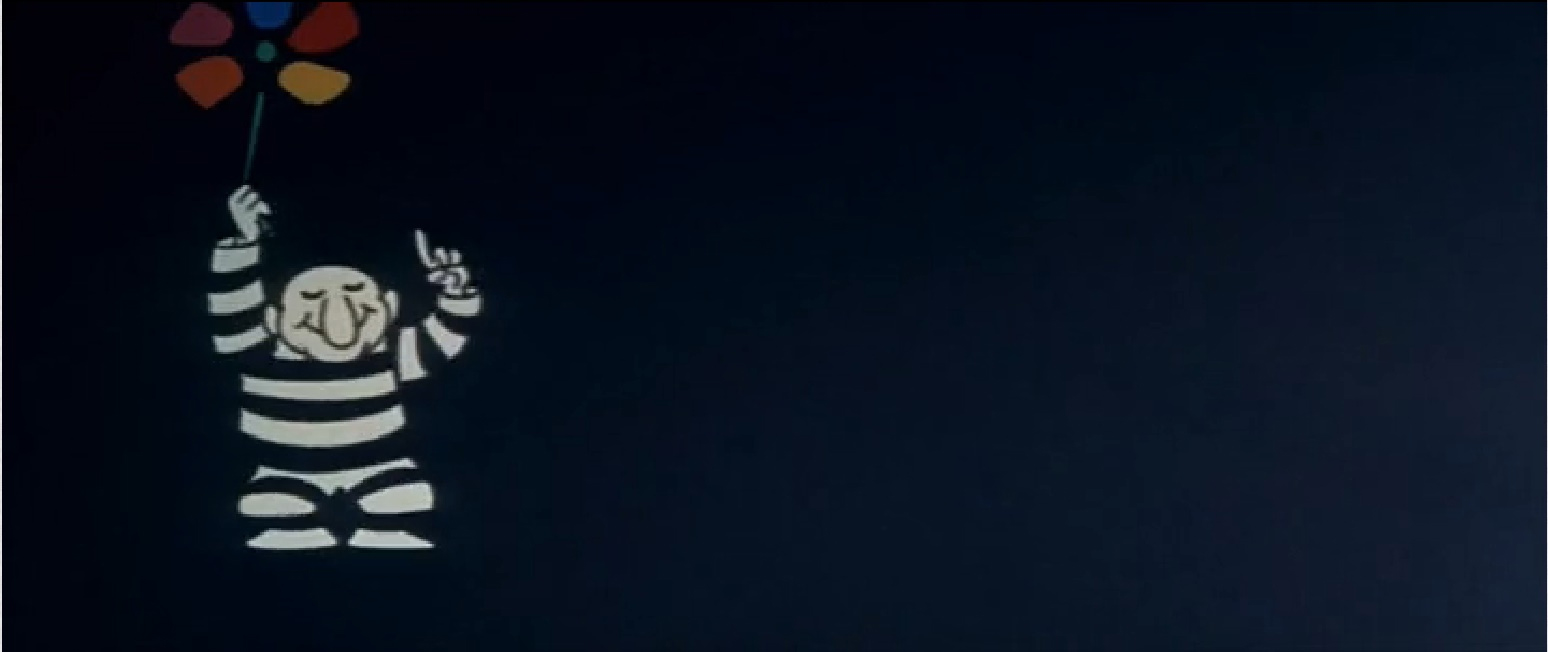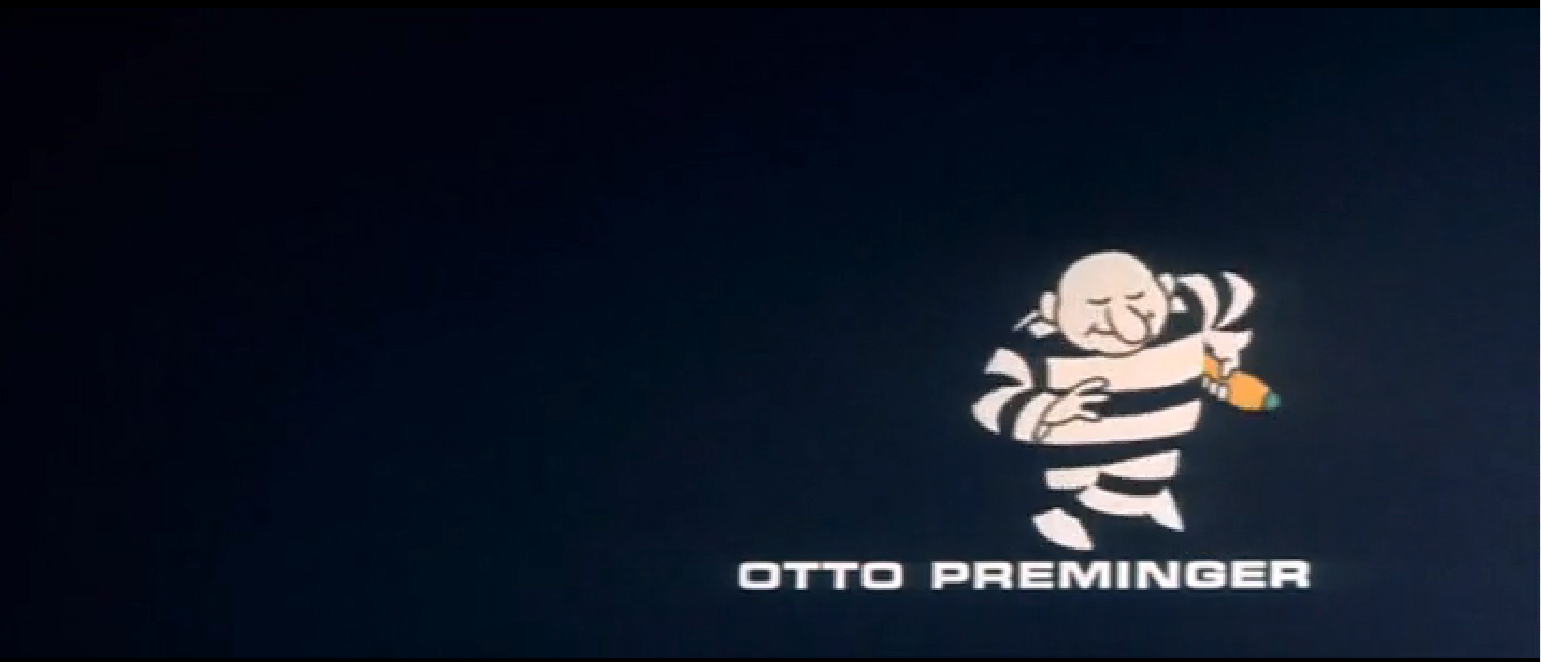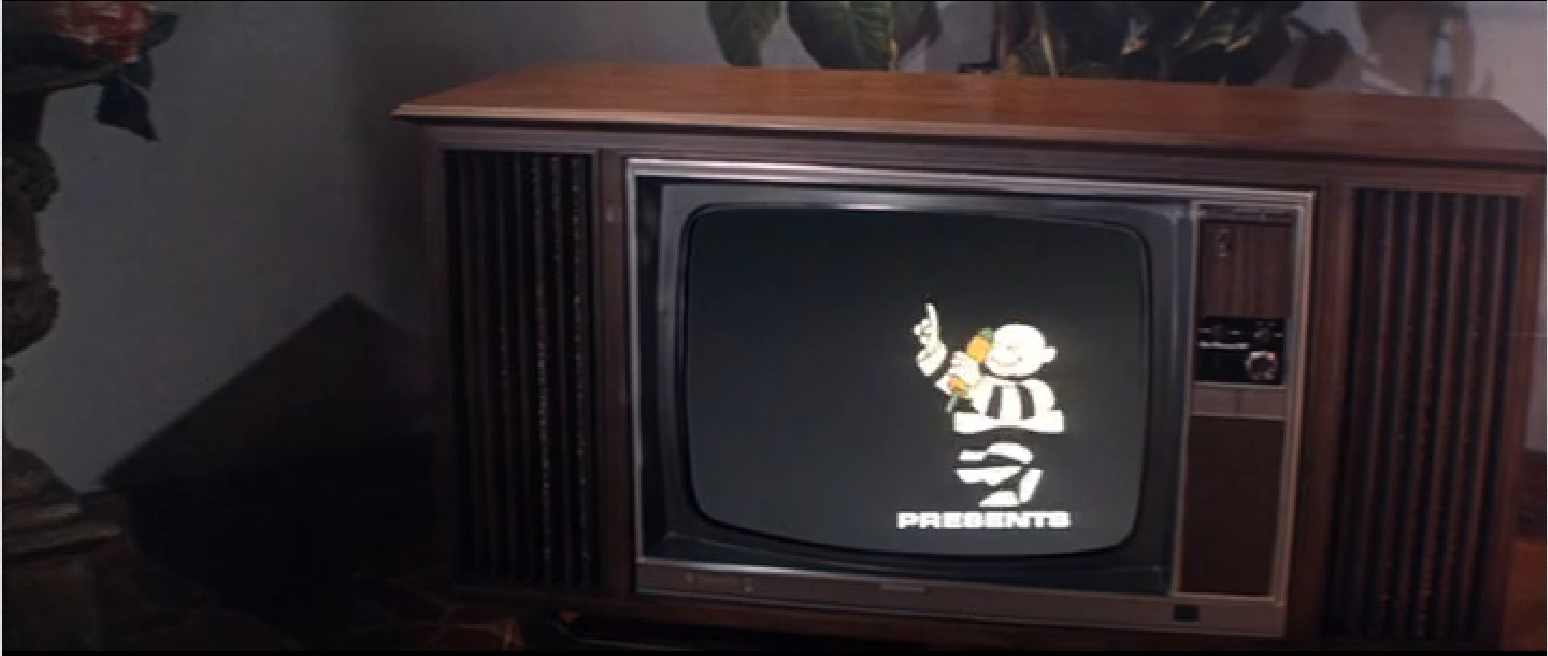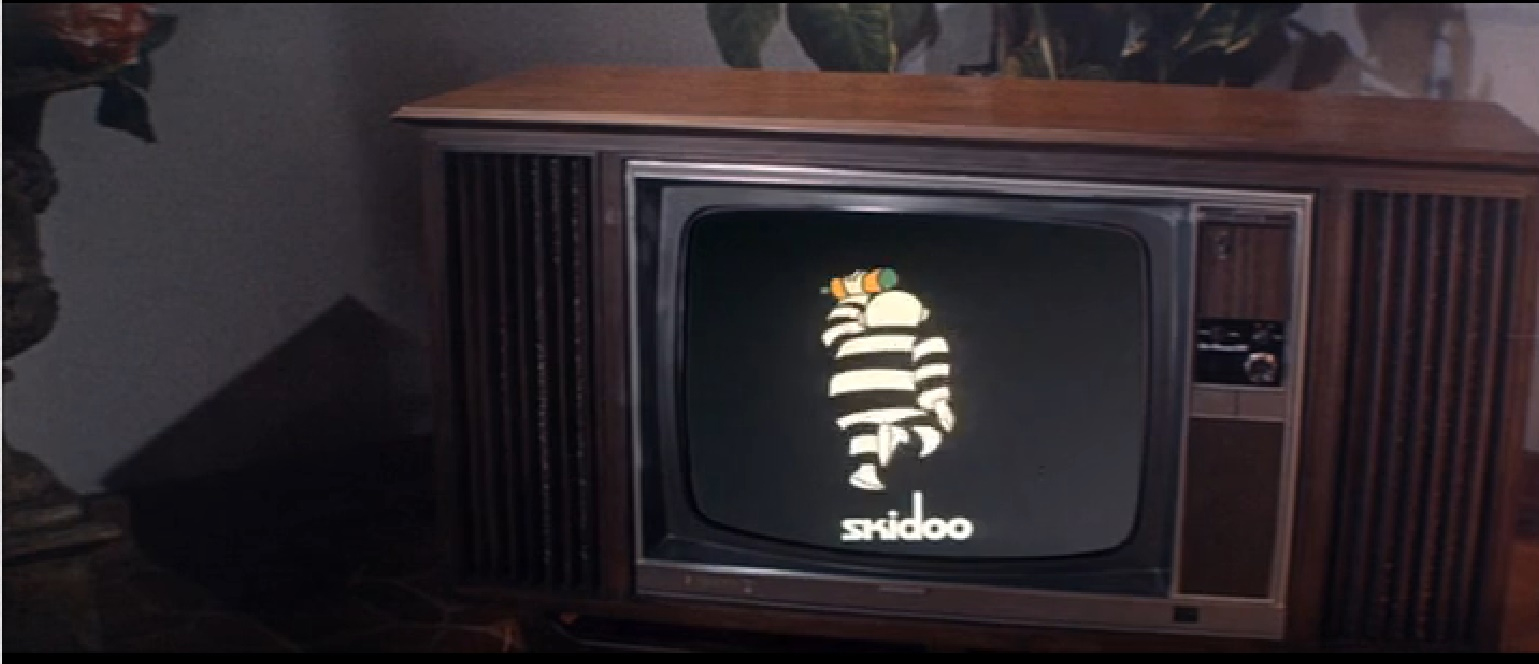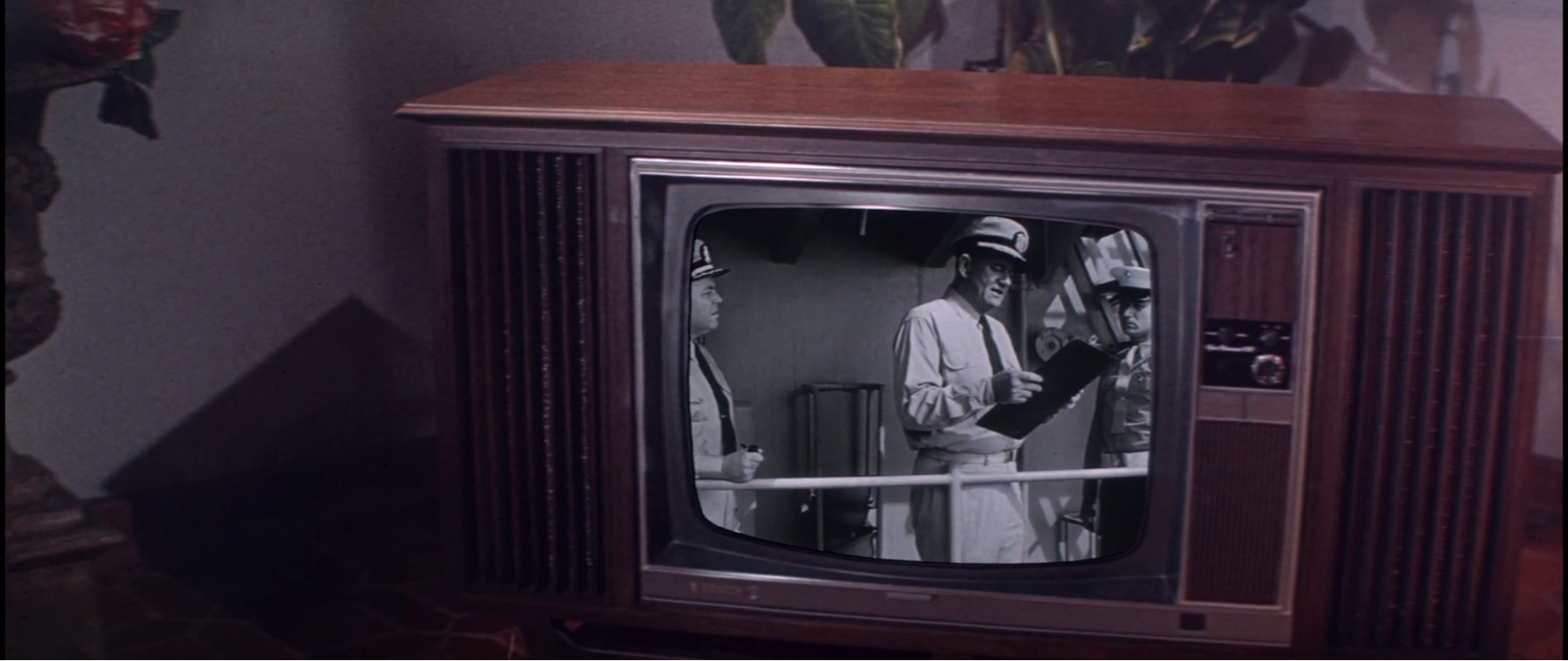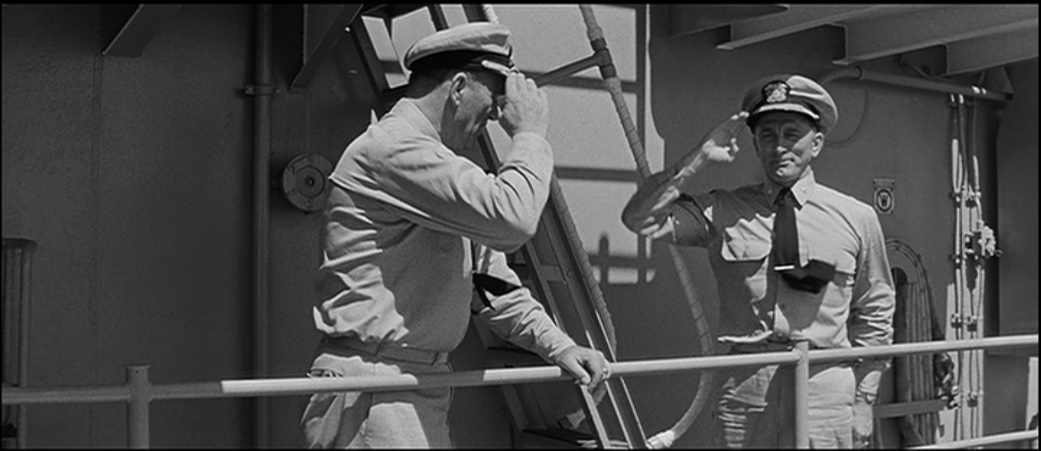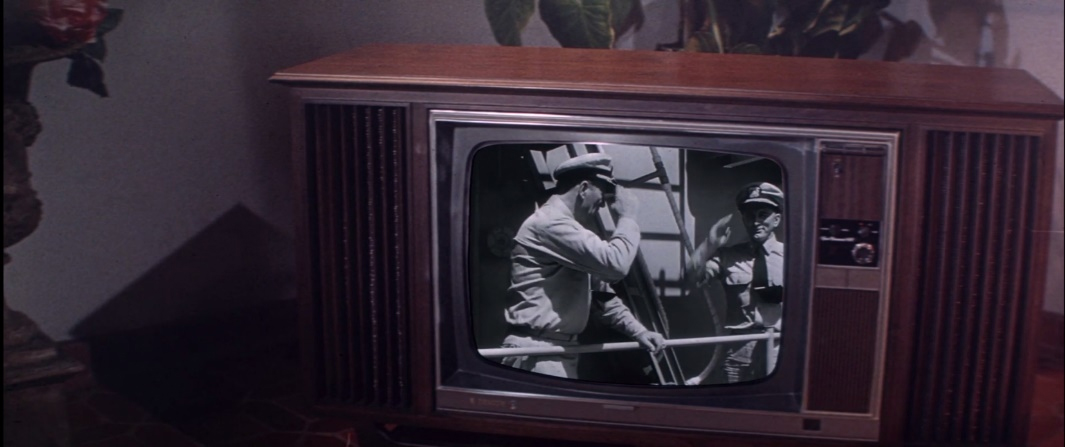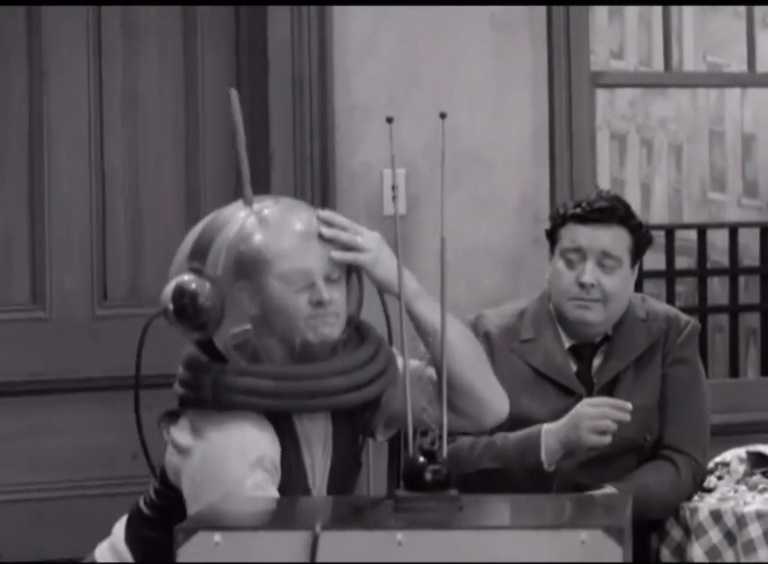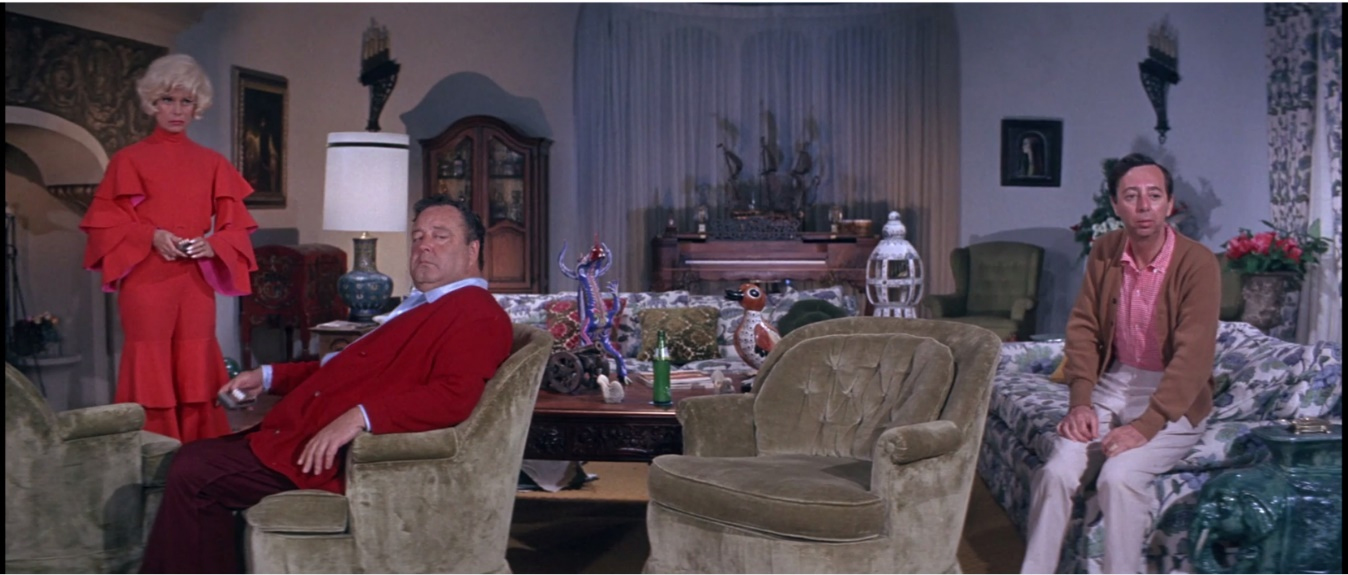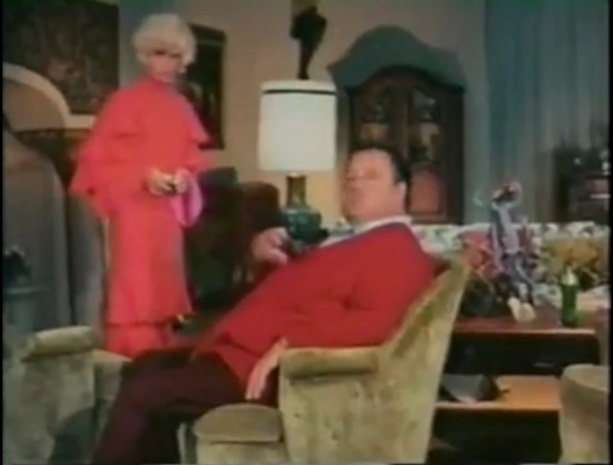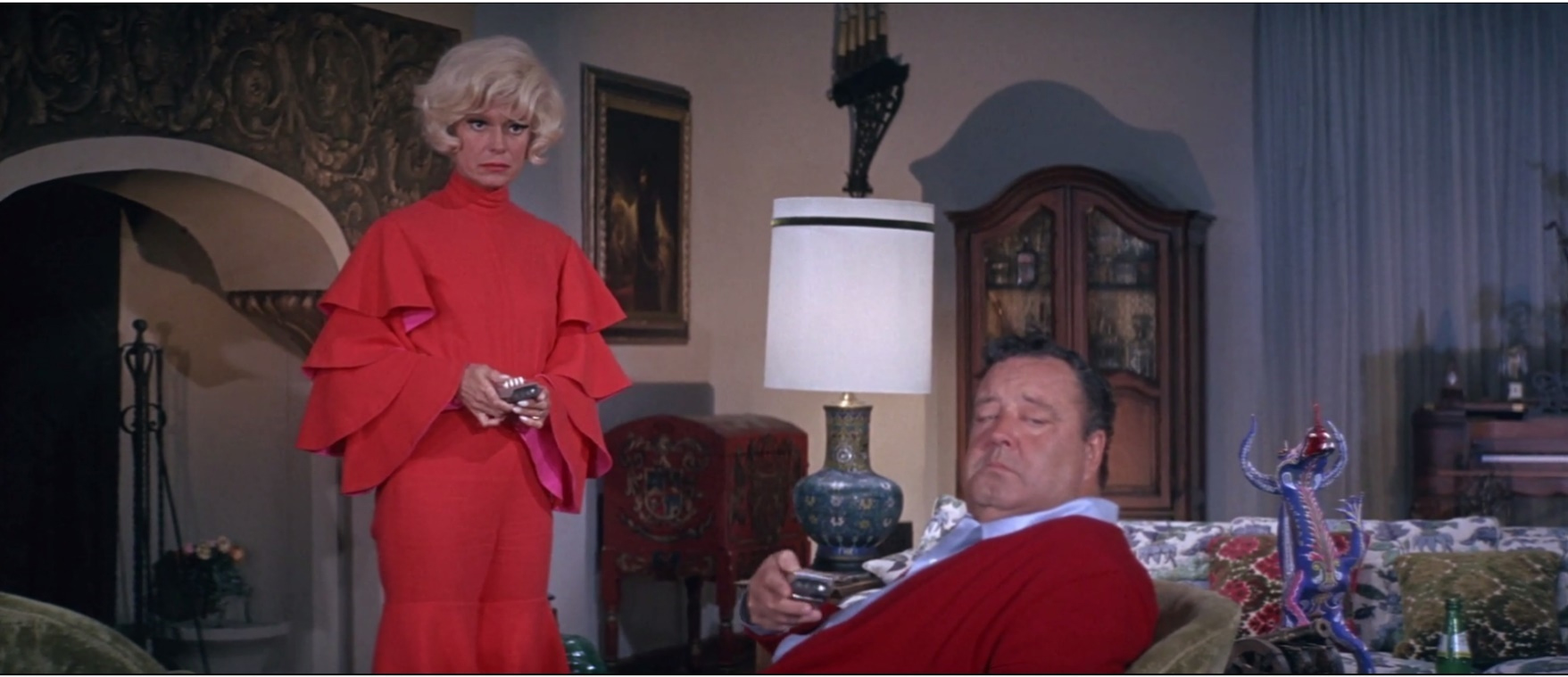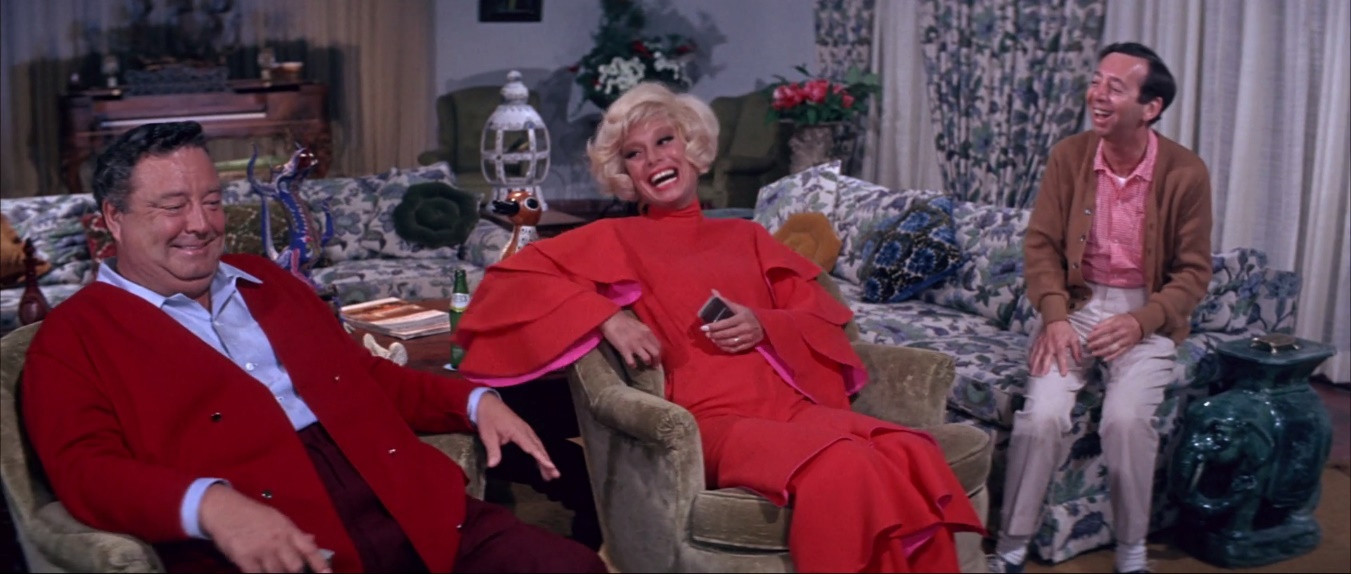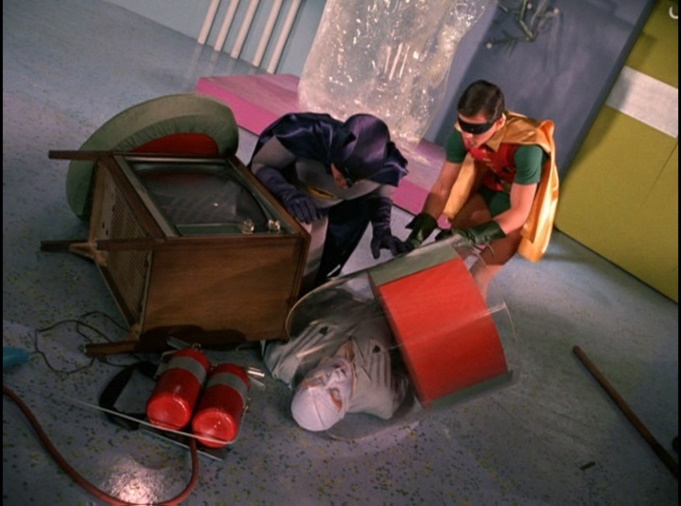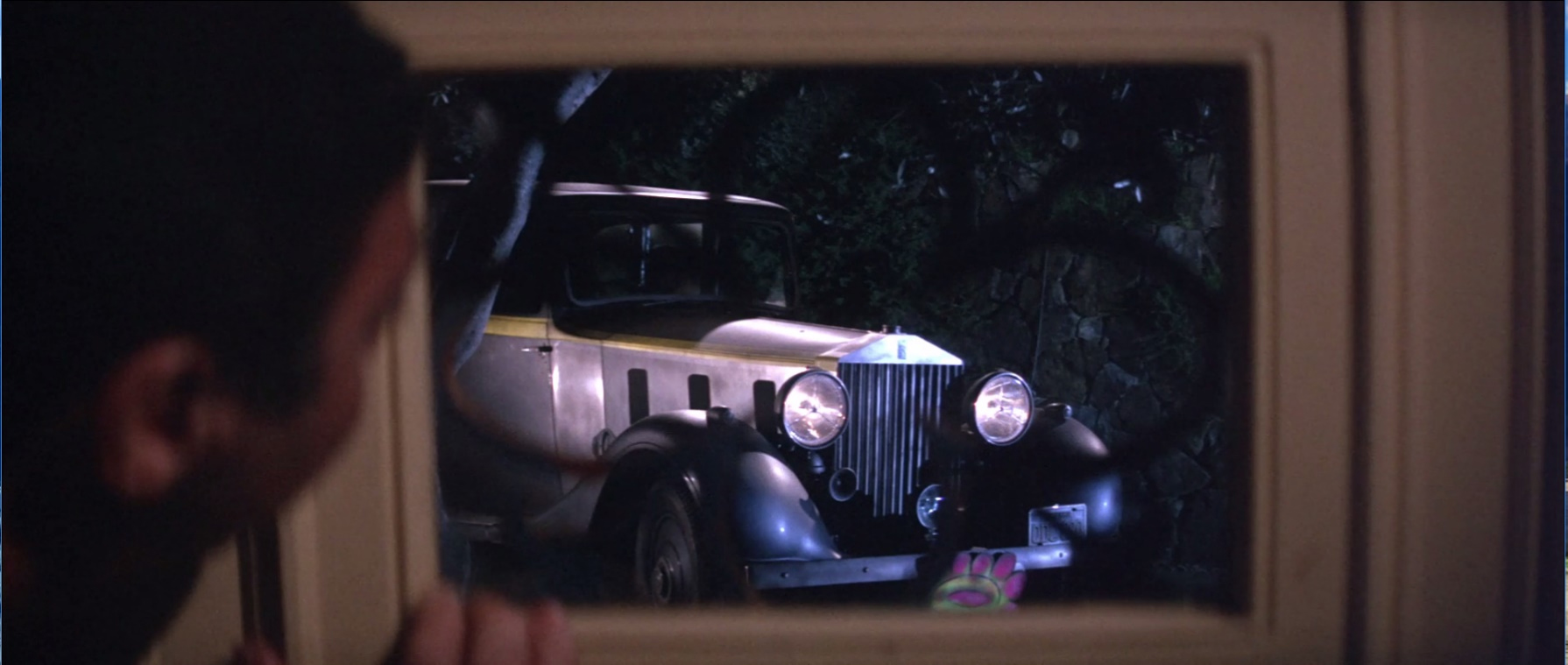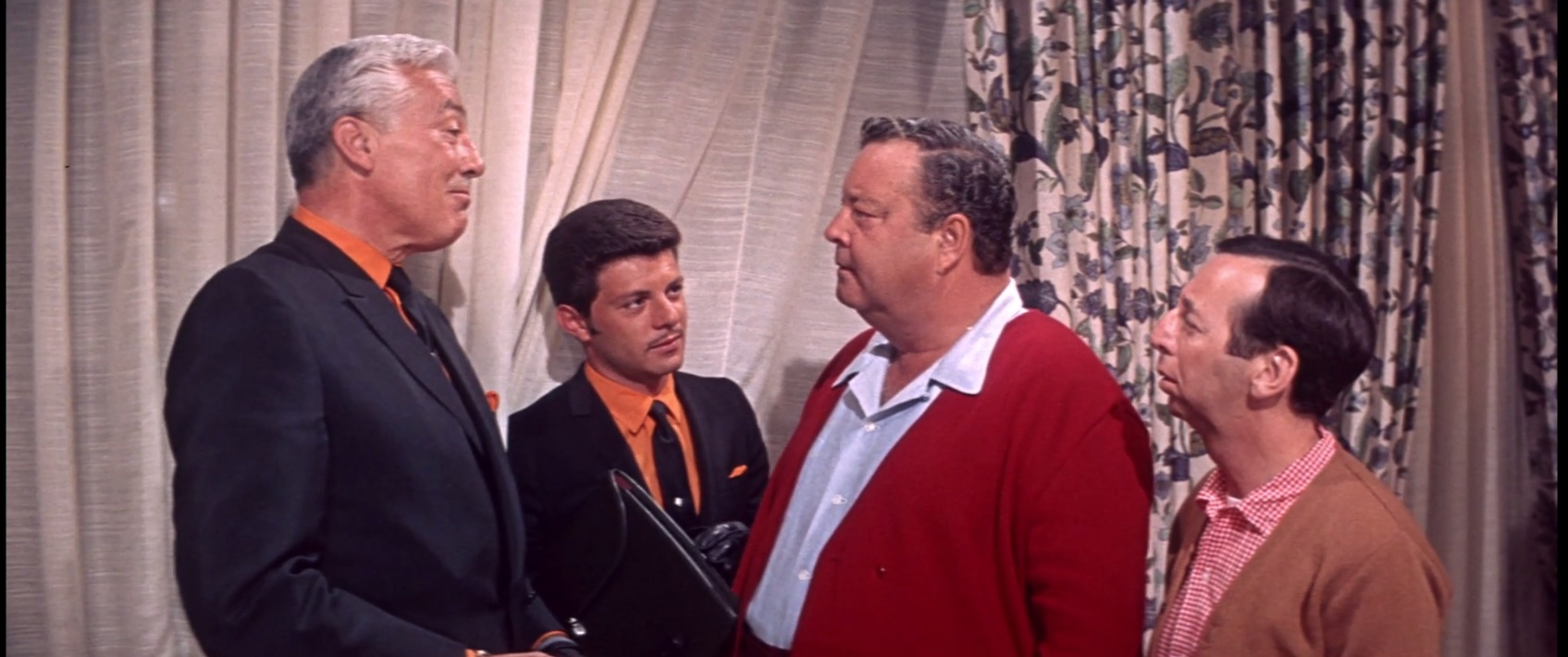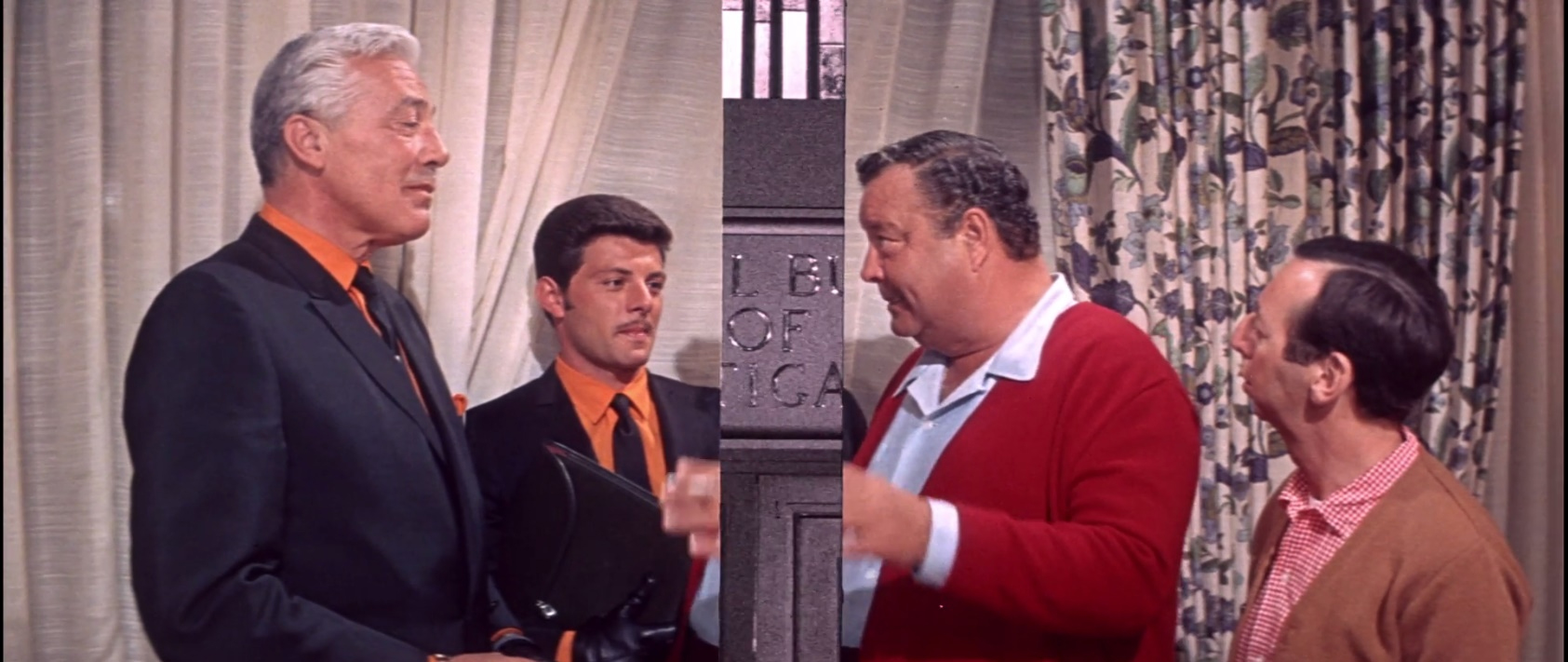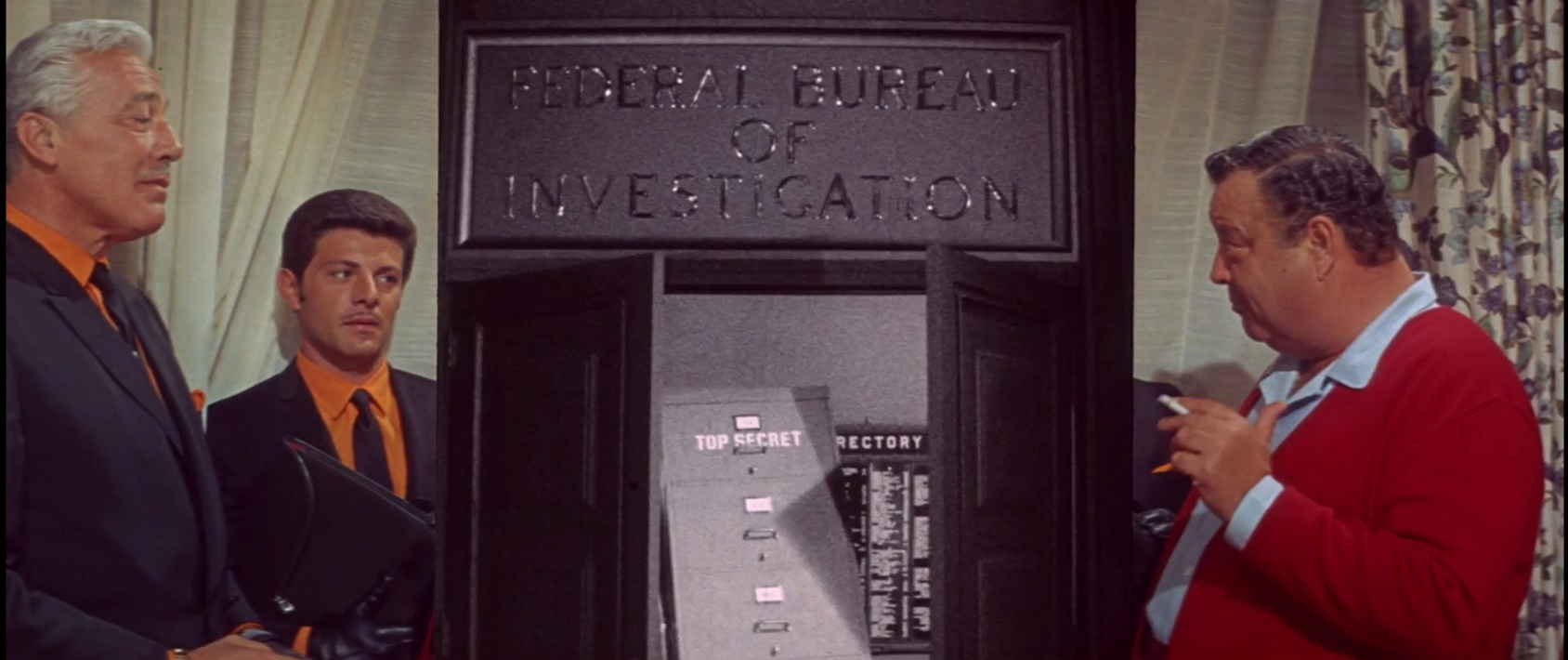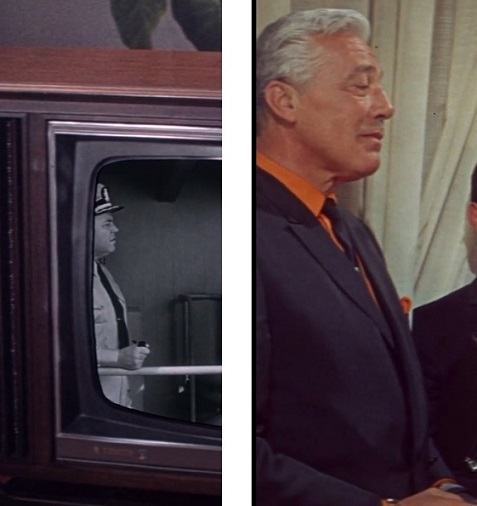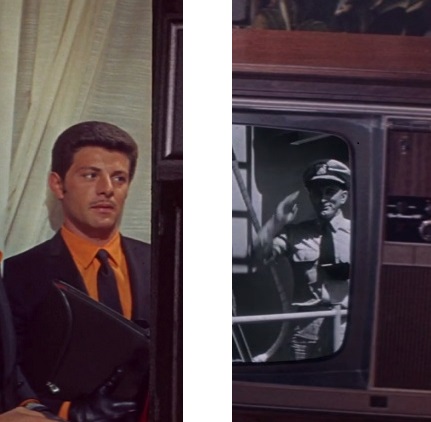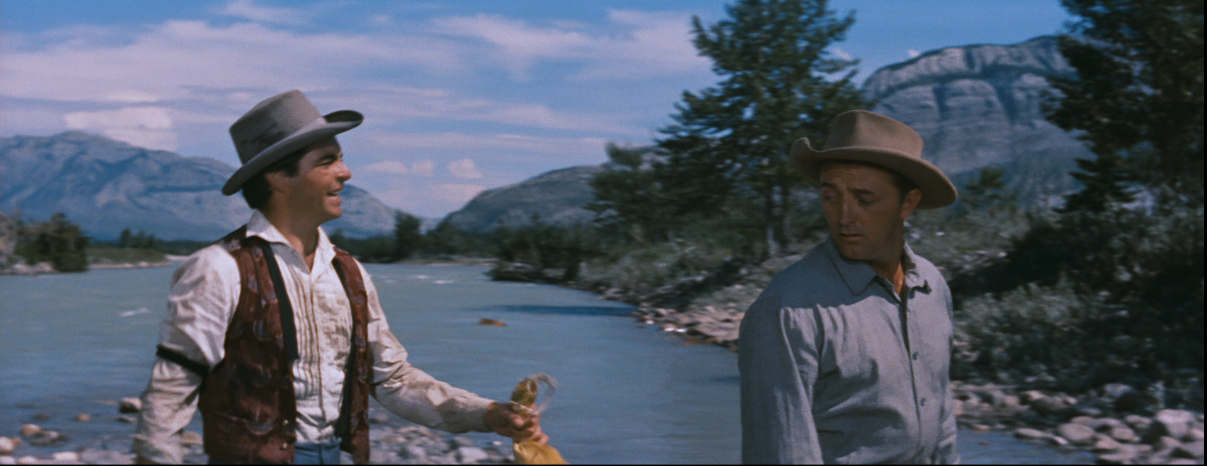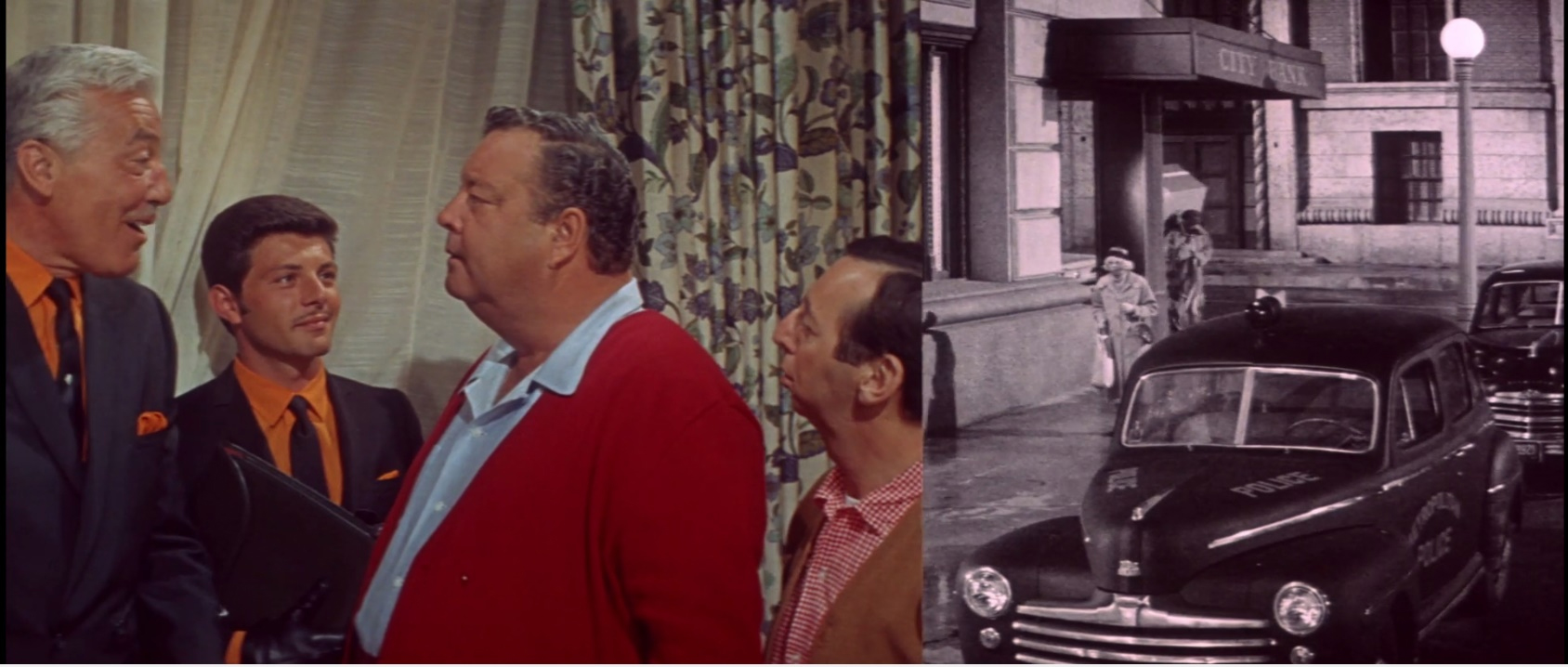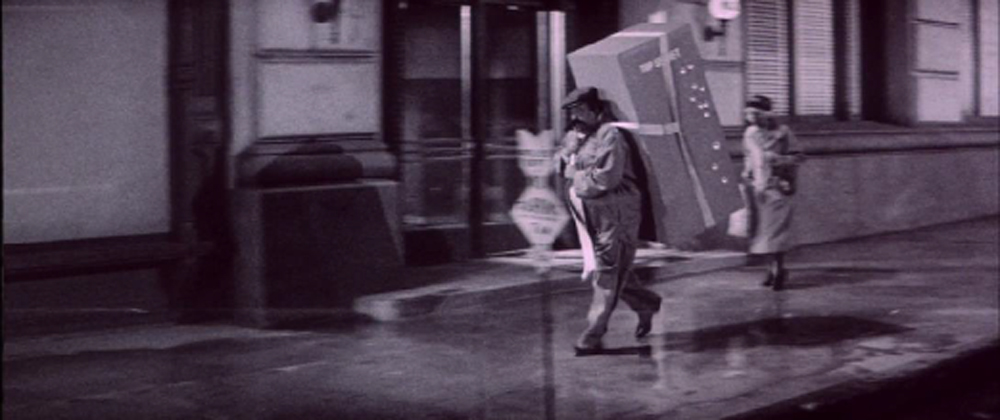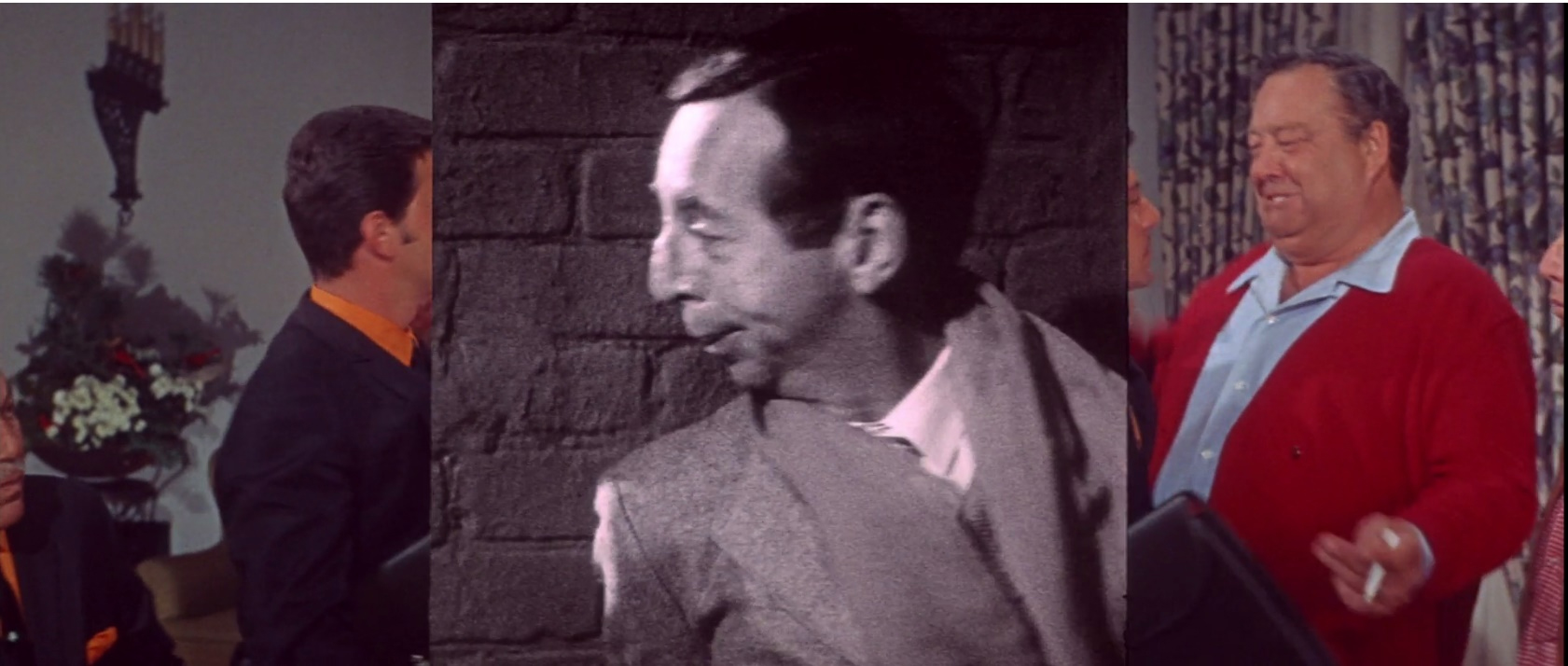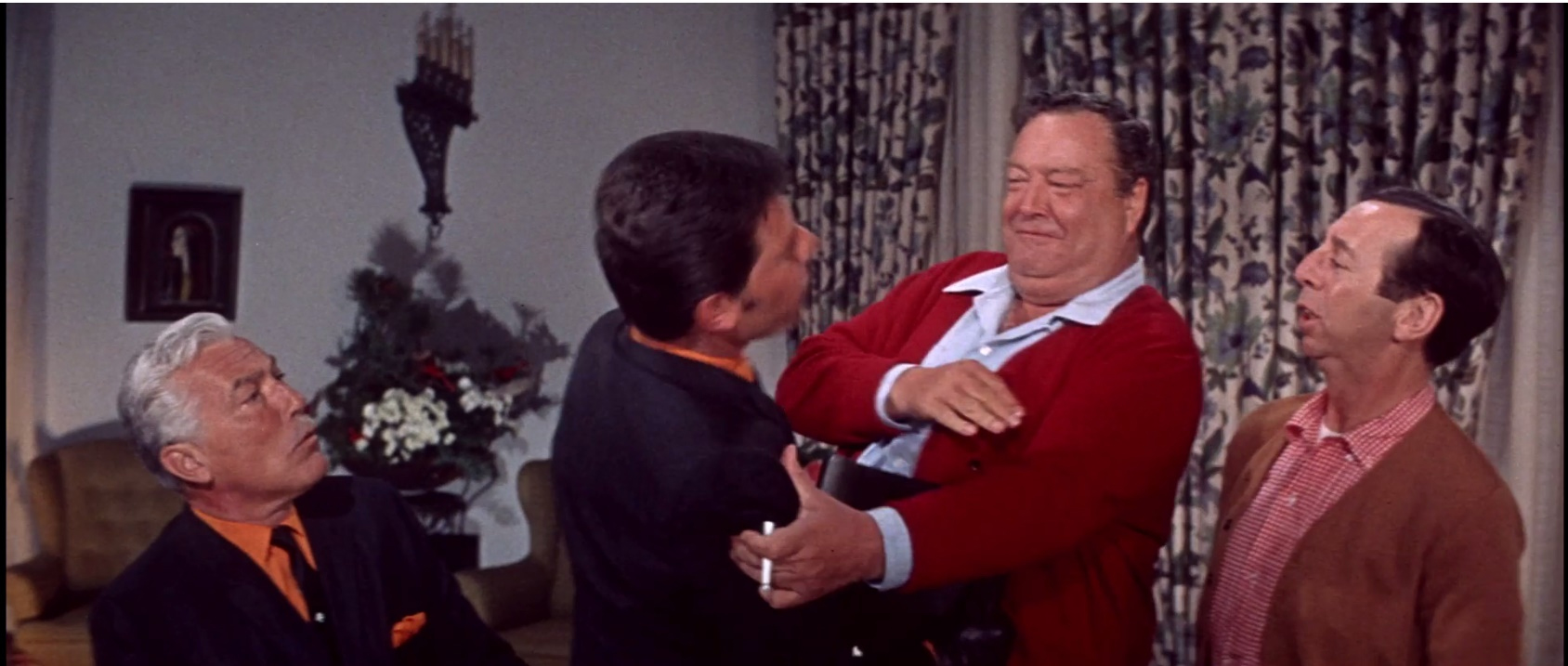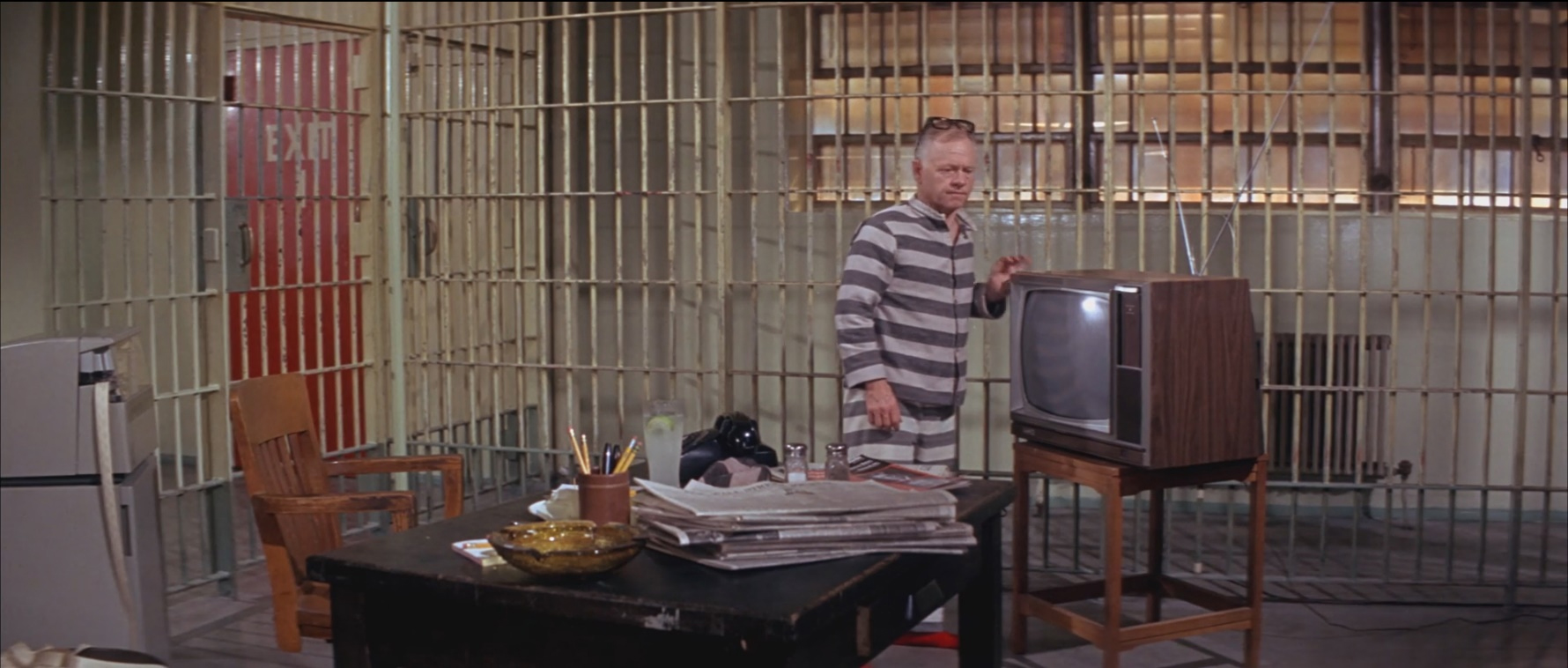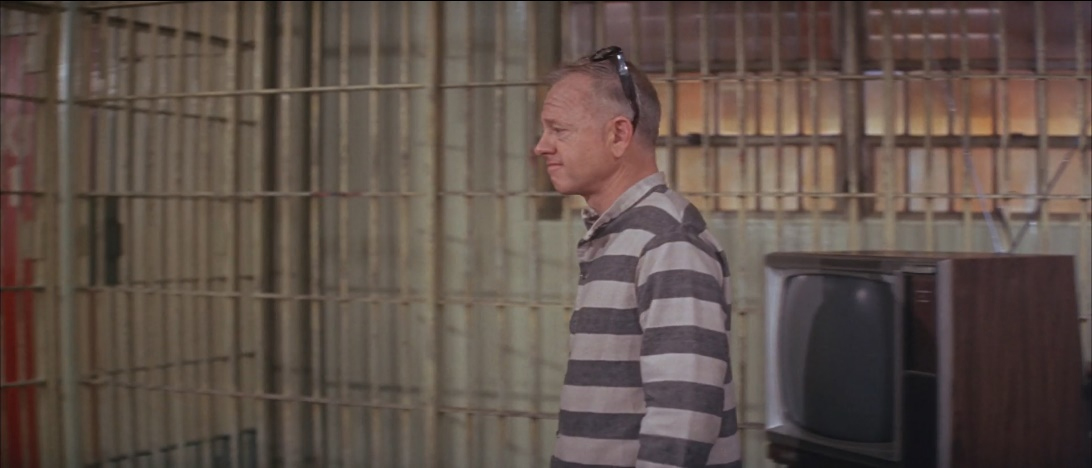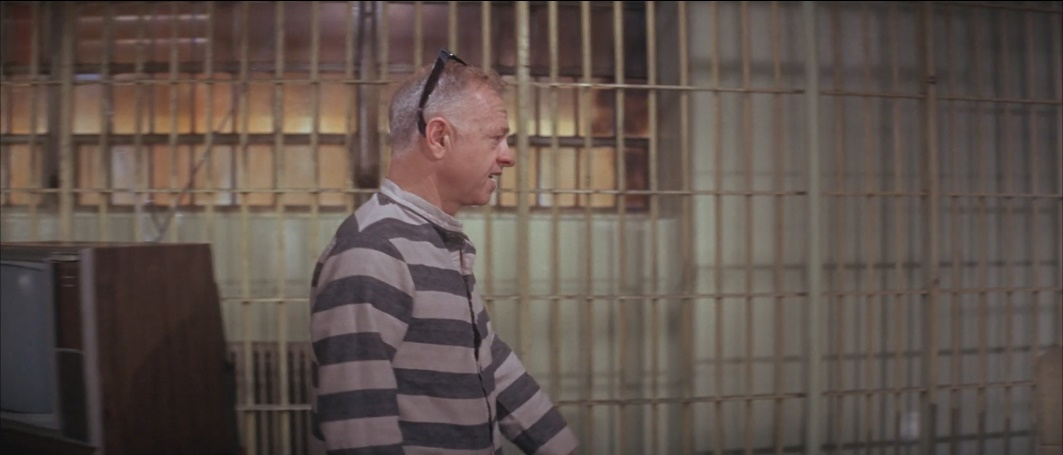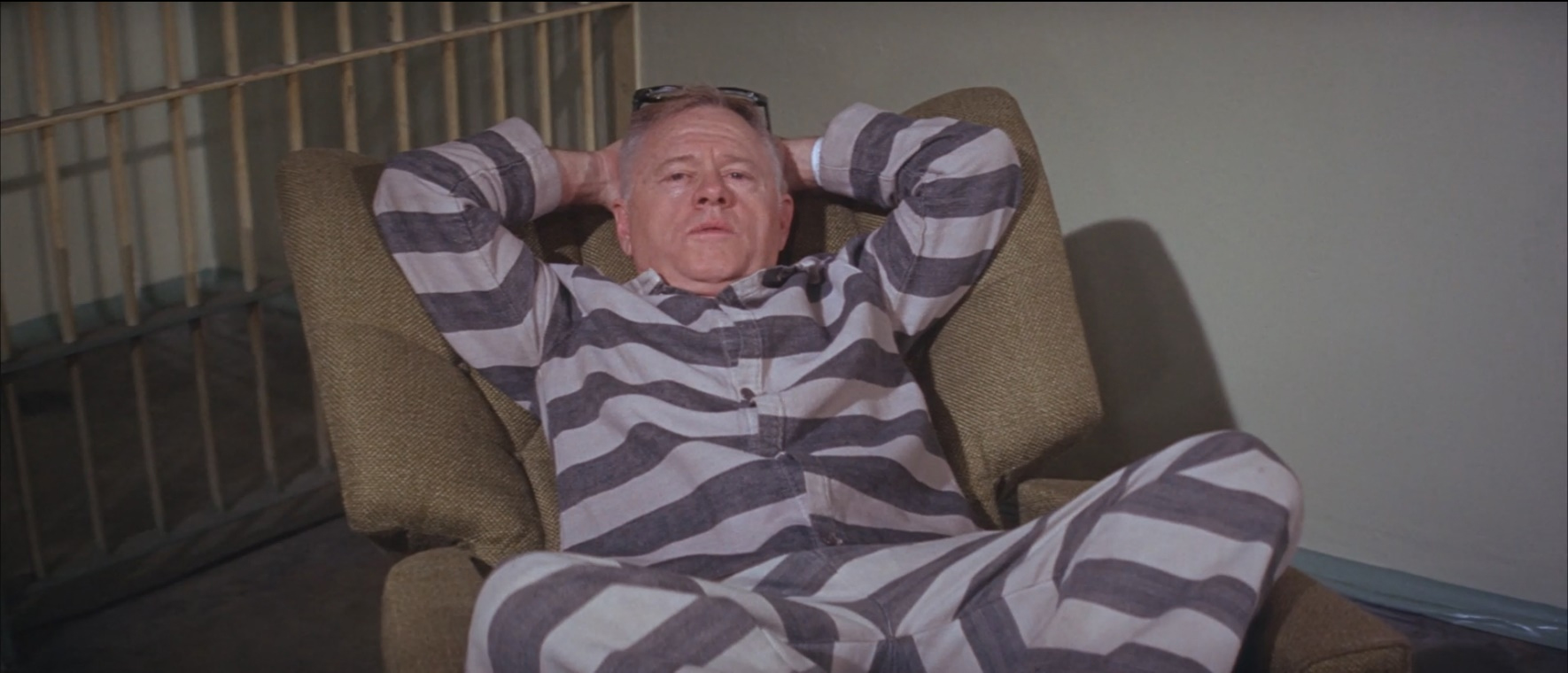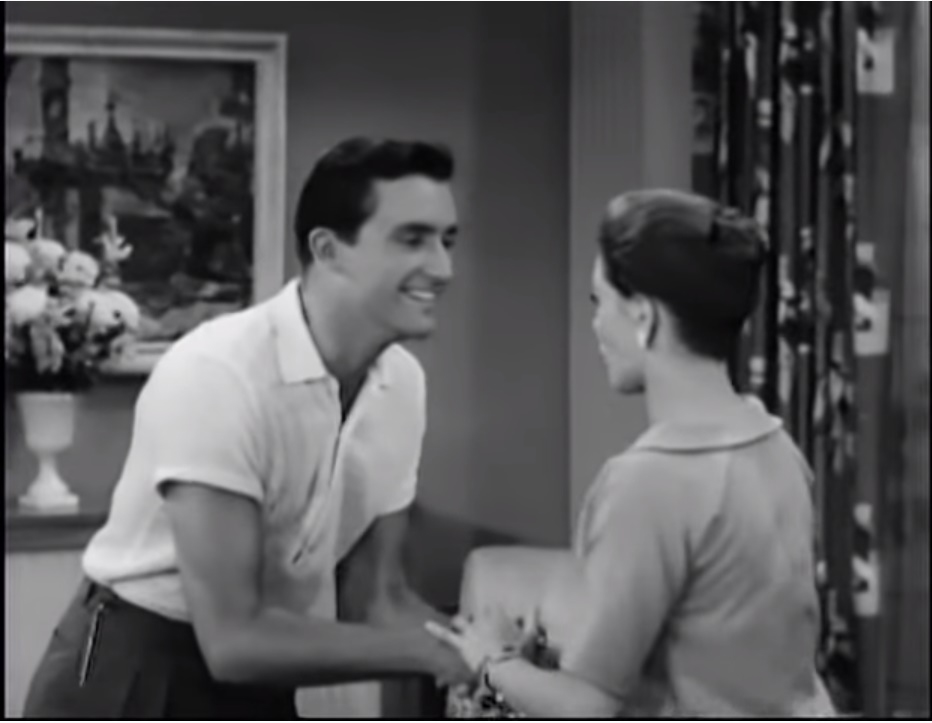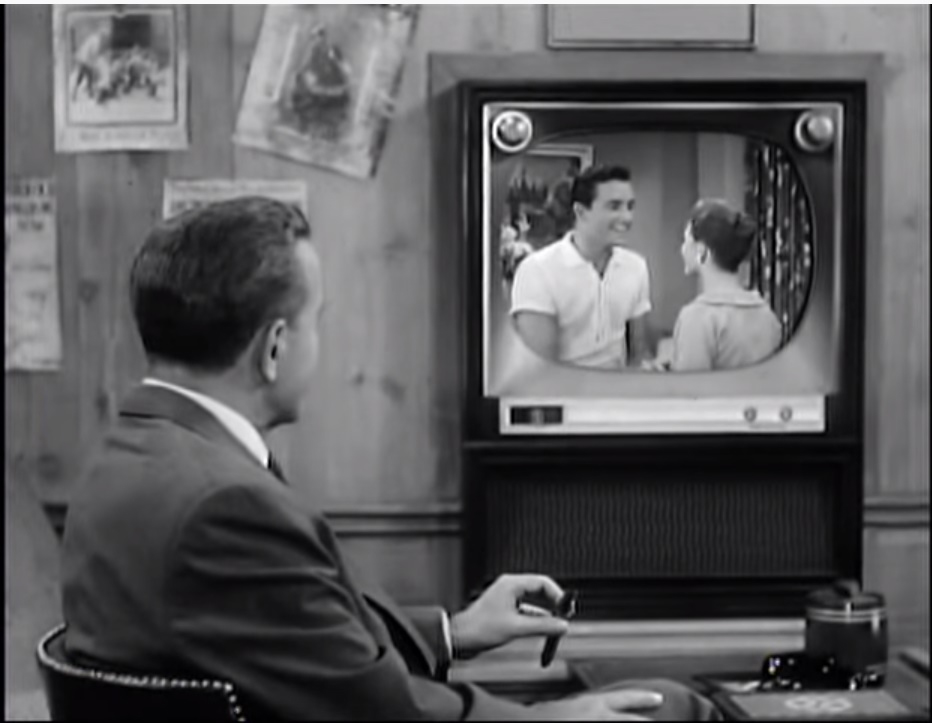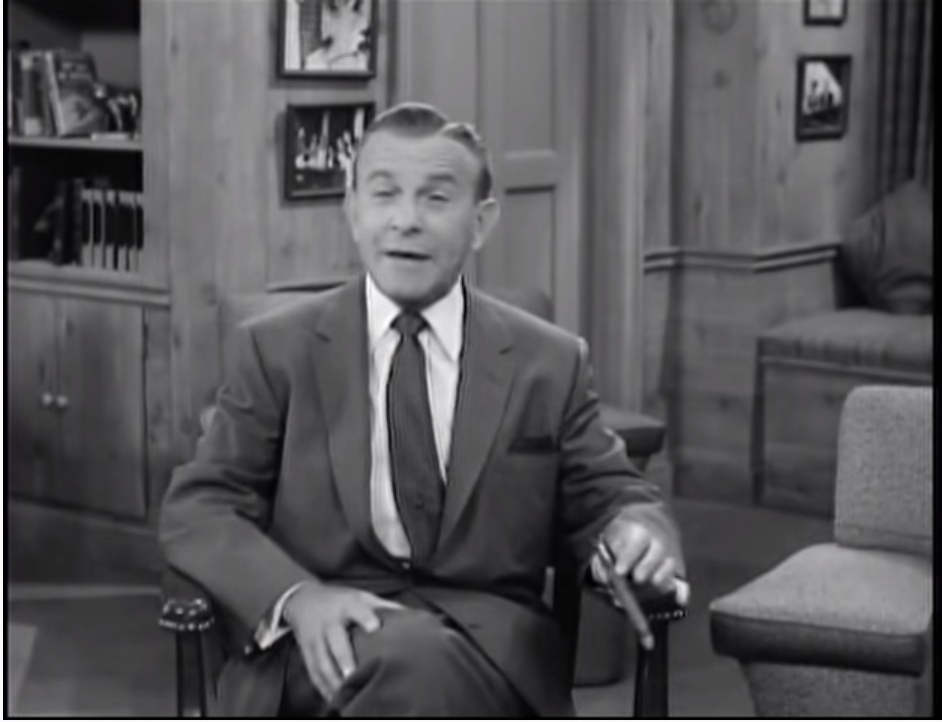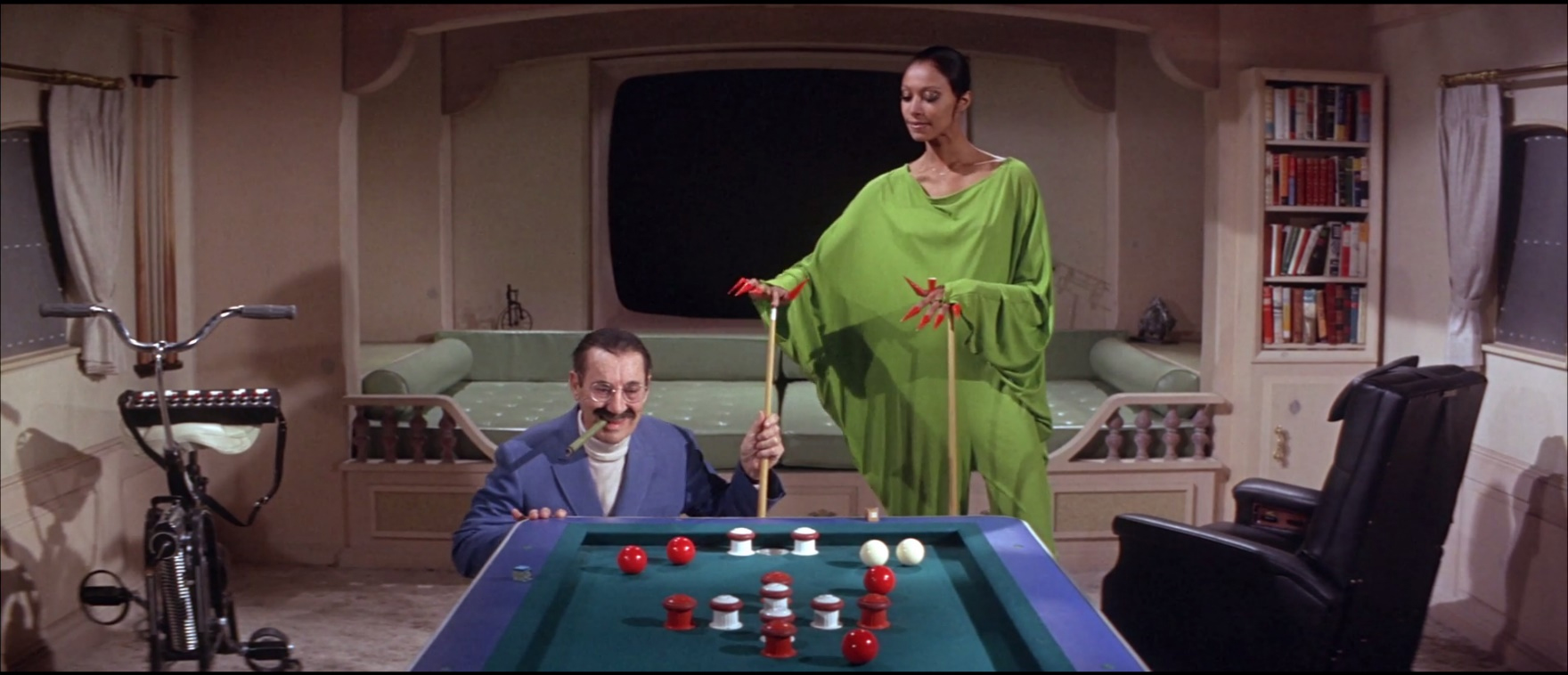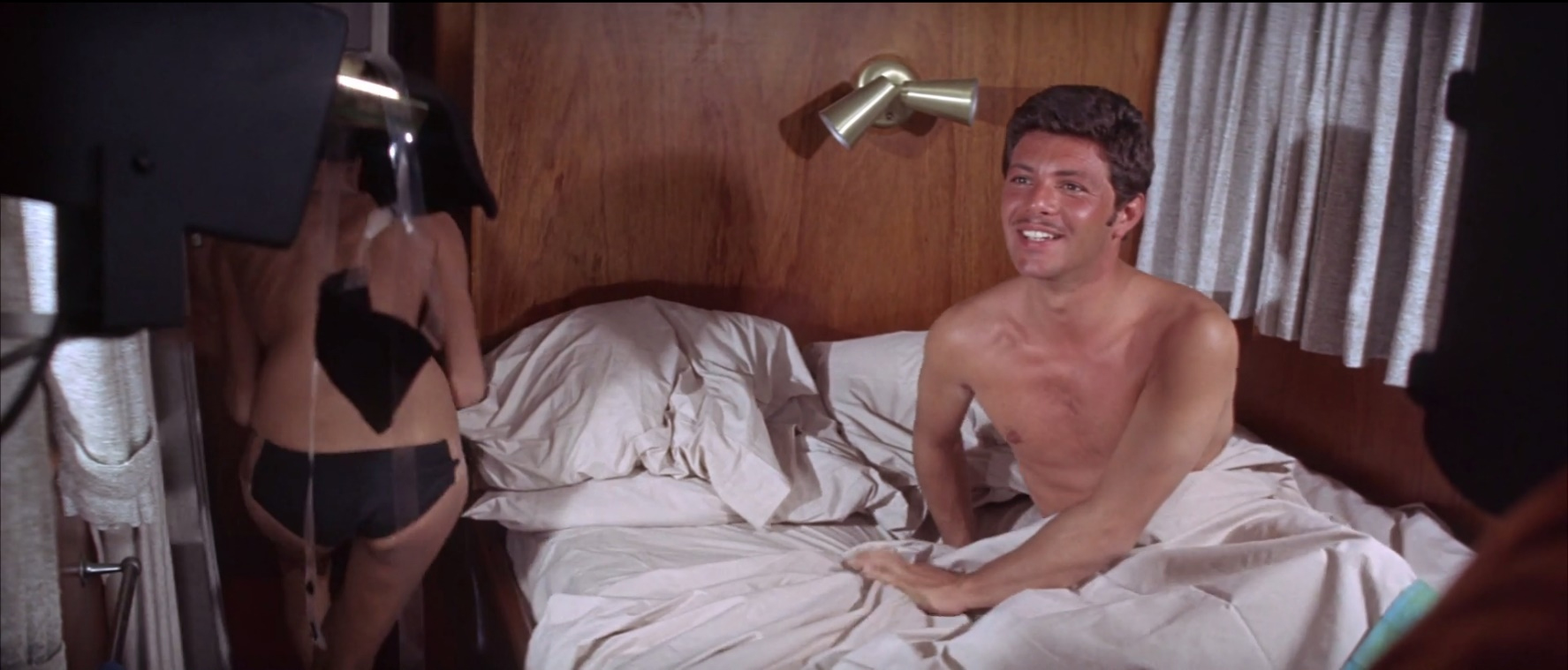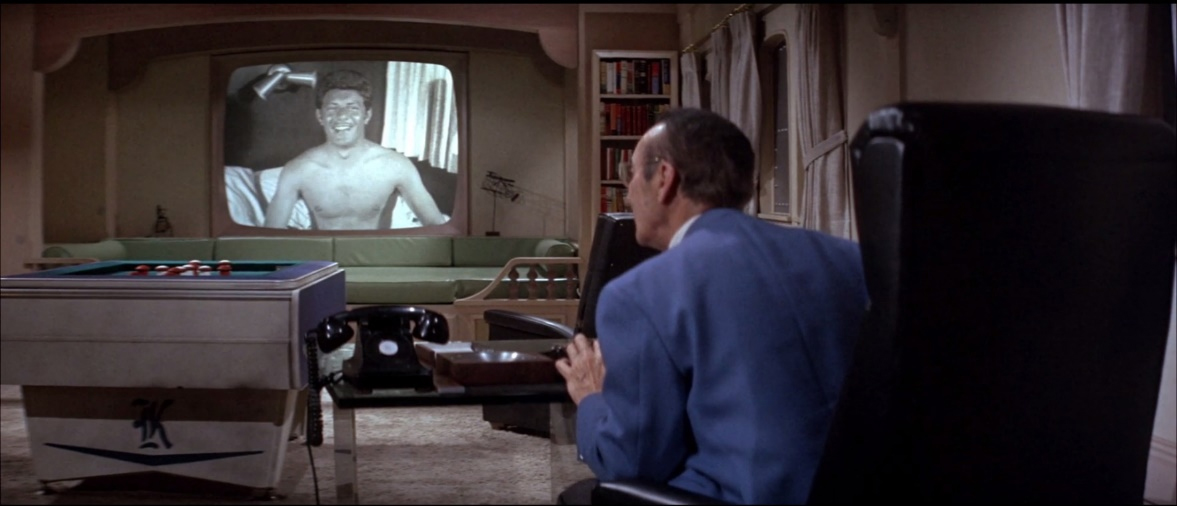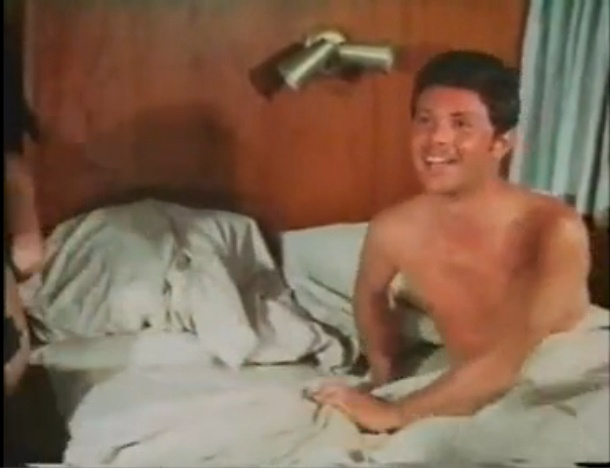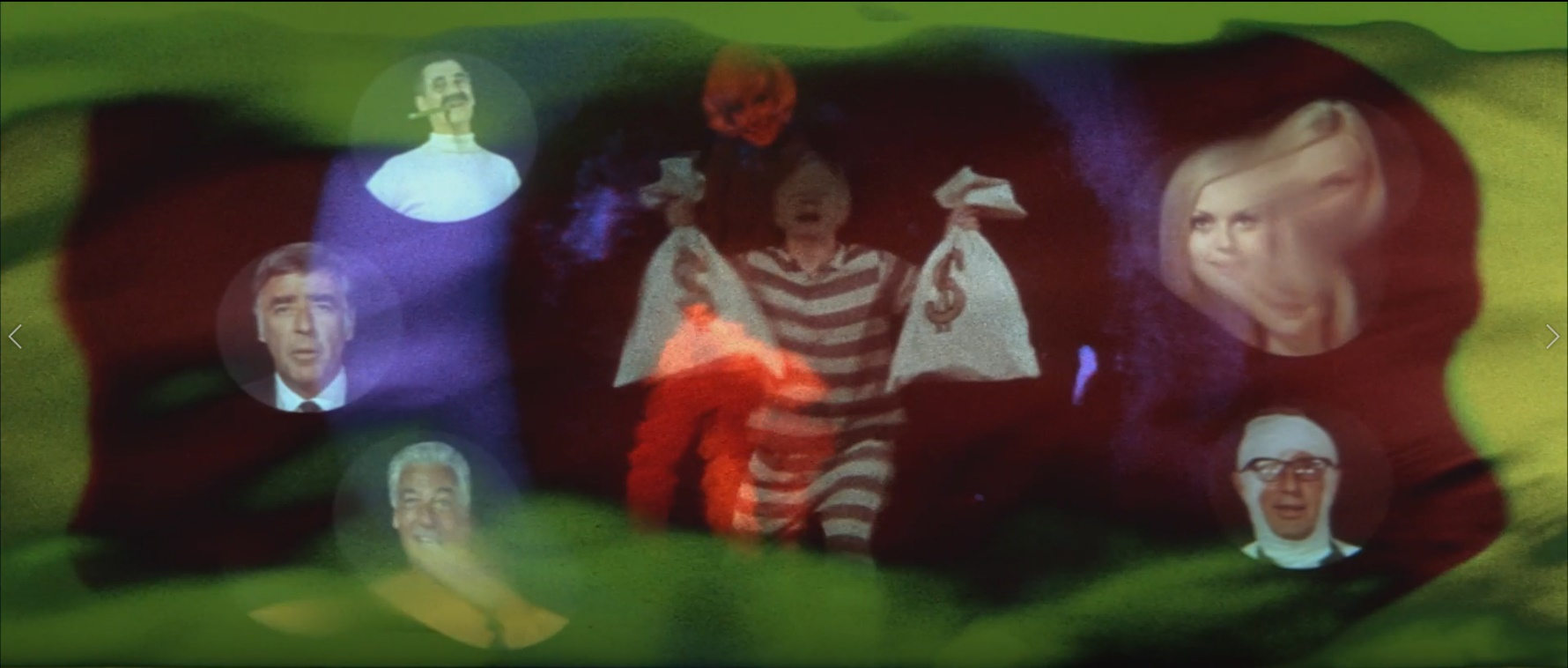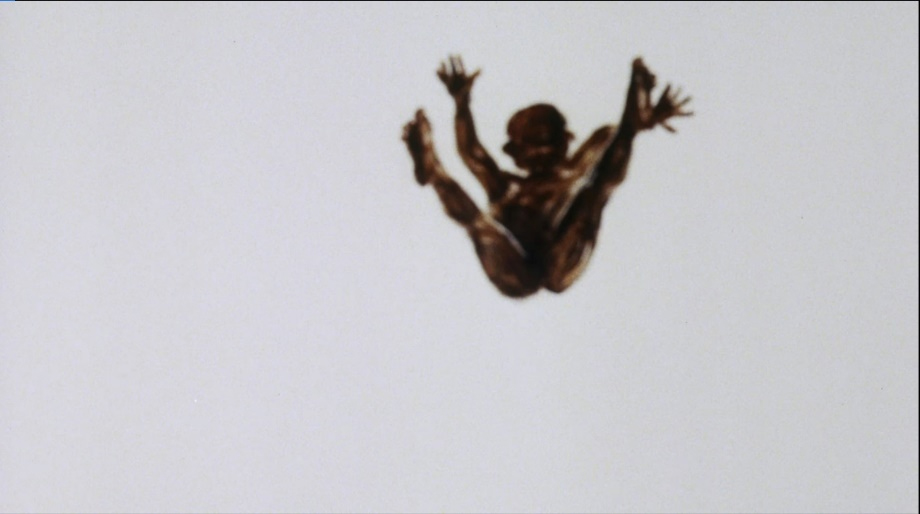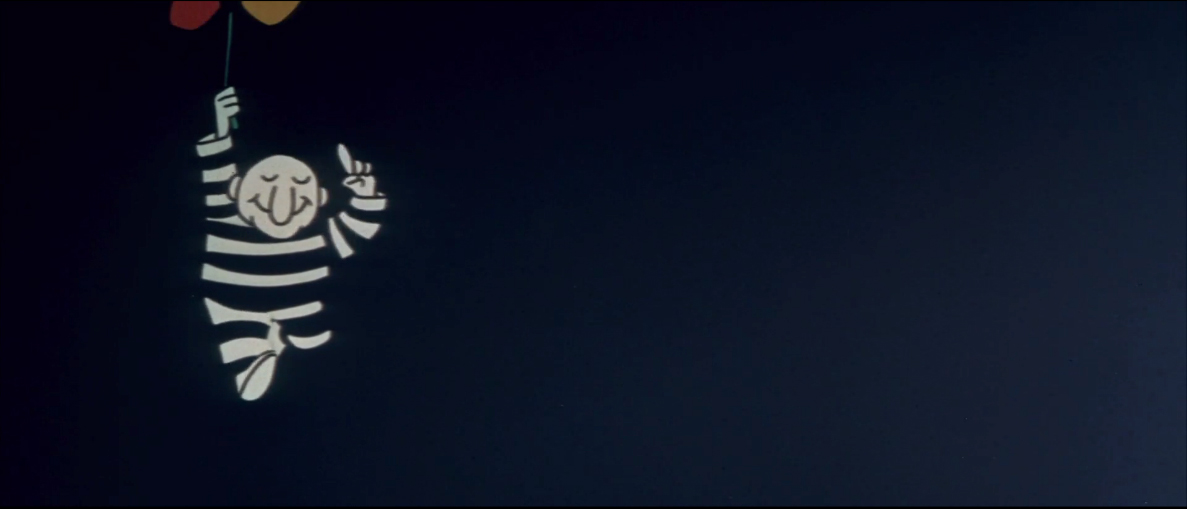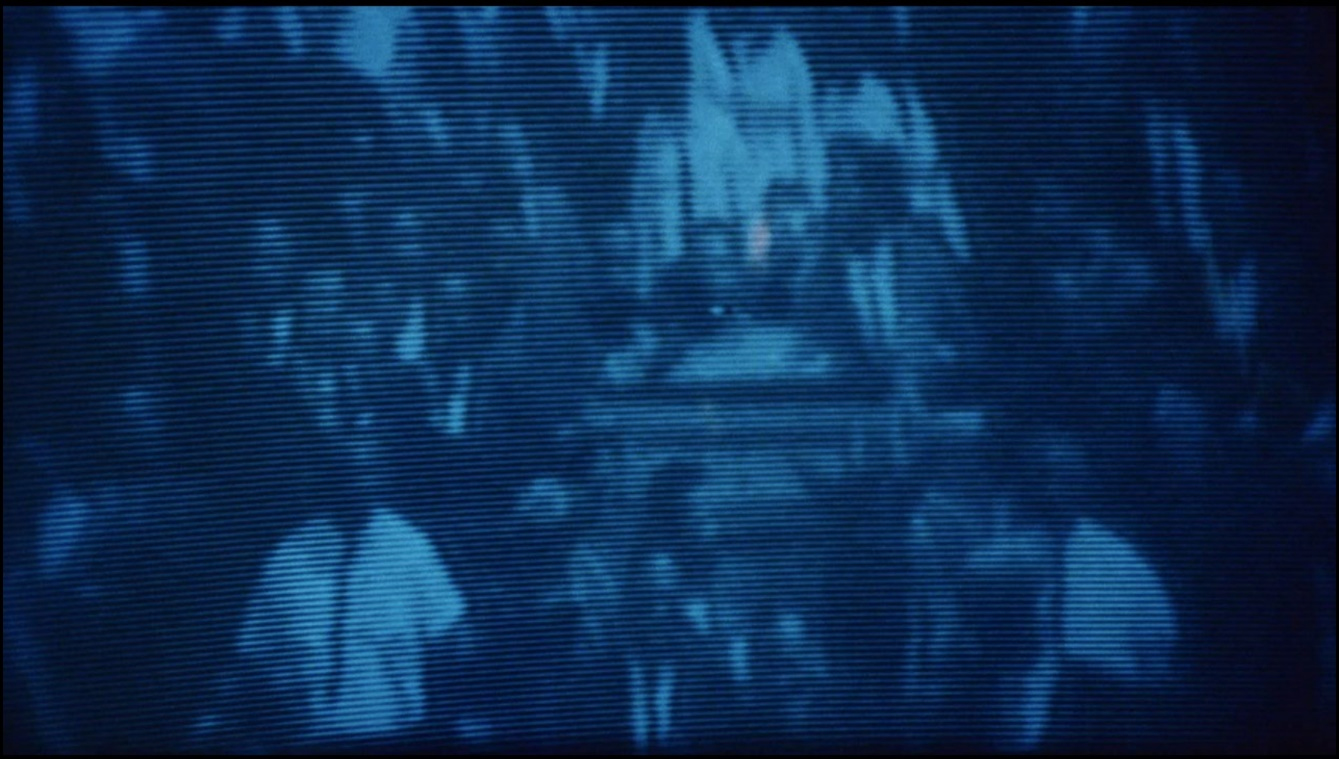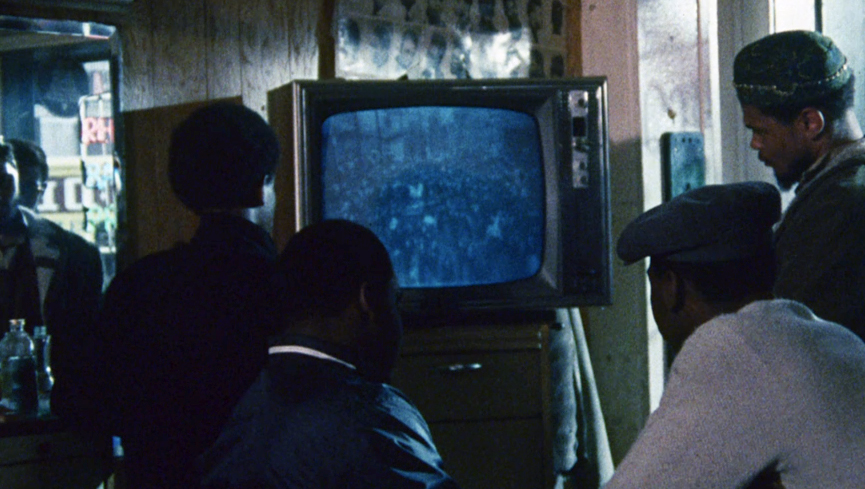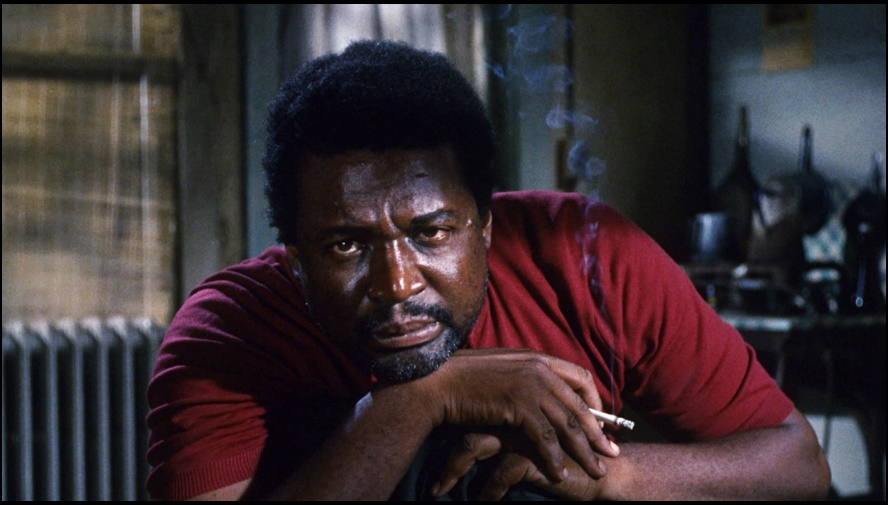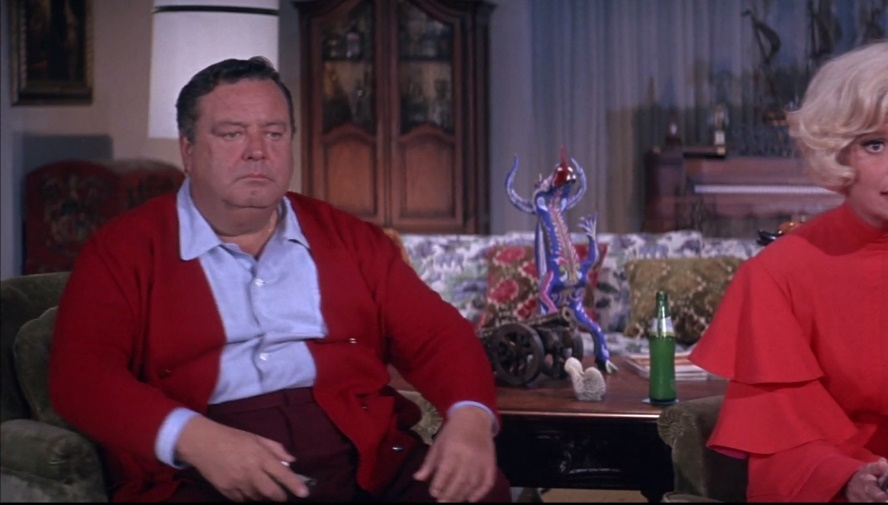Skidoo begins as a prison-striped cartoon parachutes into the frame. He is guided by a rainbow-colored umbrella that gaudily contrasts the black-and-white stripes of his outfit.
He lands, collapses the parasol, and begins to shuffle to the right as the name “Otto Preminger” appears underfoot. The bald figure even looks like Preminger, sporting his defining bald hairstyle (errr….head-style?).
Then something quietly unexpected happens. What we took to be a movie screen, one about to divulge its opening credits, now reveals itself to be of an entirely different ontological order. As the jailbird shuffles his way back to the left, what we discover to be a camera pulls back, revealing that the image resides on a television screen.
Only something appears off. Look closely at the two images above: the cartoon has remained the same size despite the suggestion that the image is becoming smaller (farther away) in relation to the camera’s rearward tracking. Instead, what we actually see is the image being mediated right before our eyes, the television façade cropping into the image from both left and right, altering its dimensions in a perceptually impossible manner.
It is only after the TV set fully occupies the widescreen space that the scale appears correct. But there was a fleeting moment when the widescreen frame and TV image appeared impossibly continuous.
The switch from widescreen to TV is also a move that re-contains our escapee. No longer free to dance in the seemingly unbounded black space, he rebounds from the new-found wall—perhaps a prisoner-escapee of the sort frequently found on TV shows of the day: Mission Impossible (1966-73) or the more colorful The Prisoner (1967-68), for instance. Even starting a live-action show with a cartoon introduction was typical of the era’s TV—Bewitched (1964-1972), Batman (1966-68), The Carol Burnett Show (1967-1978). Even I Love Lucy (1951-57) originally ran with cartoon versions of Lucille Ball and Desi Arnaz interacting with the sponsor’s advertisements. While audience may have come to a theater to watch a film, the rest of Skidoo largely takes after television of the day—there’s singing and dancing, celebrity guest appearances, and elements of both sitcom and television crime drama.
This single shot, with its curious way of relating the widescreen film image to the smaller television screen, distills a certain tension that much of Skidoo will continue to unfold: an unexpected “squaring” of film and television aesthetics of the late 1960s. While many film and television scholars have come to treat these respective media as commercially and institutionally interrelated,1 their historical-aesthetic conjunction has rarely, if ever, been the subject of detailed film criticism. Broadly speaking, television aesthetics have long been found in films, especially with New Hollywood filmmakers of the 60s and 70s—more cuts, more zooms, more one-shots, more close-ups.2 But when it comes to films playing on TV, television is nearly always viewed as harming the original work—especially if that film were widescreen, as many had become by the mid-1950s.3 While this may no longer be the case with films streaming online, back in the 1960s films might be cropped, interrupted by commercials, butchered by the addition of cuts and pans, transmitted with lower image and sound quality, and exhibited in the viewer’s home where, among other potential distractions, the channel can be changed. Skidoo, though, has a different take on the aesthetic relationship between the two media. Rather than seeing television remediation as harmful to the original film, Skidoo finds a place for it on the widescreen.
If you’re thinking that such a film would be quite unusual, you’re not alone. As one supporter of the film has put it, “Preminger in Skidoo is on a weird page no one else was on … the minute you think it can’t get any weirder, it does.”4 TIME found that one of “the only conceivable reasons to see [Skidoo]” is “just to believe that it exists.”5 When it was first released, Vincent Canby described Skidoo as “98 minutes of disconnected story-conference ideas about a retired hood (Jackie Gleason) commissioned to dispose of a Valachi type (Mickey Rooney) who’s about to tell all to a senate investigating committee.” He finds the movie to be a “disaster” with a “complete lack of humor.”6 Other critics were equally unimpressed. Daily Variety found it to be a “dreary, unfunny attempt at contemporary comedy.”7 Preminger-champion Andrew Sarris remarked that “audiences usually get nervous if not nasty if they can’t laugh at a comedy.”8 What kind of comedy is that?
Today, the film (if it is discussed at all) is seen more as a curio. Jonathan Rosembaum finds an “impossibility of coming away from Skidoo with any sense of certainty about anything.”9 Richard Brody has called the film “one of the most wonderfully strange movies ever made in Hollywood … an astonishment of tone and style from beginning to end, literally.”10 Dave Kehr has found it to be “a finely controlled mess, one of the most uncomfortably evocative films of its time,”11 while the Pacific Film Archive opens its entry on the film by simply stating, “Weirdness abounds in Skidoo.”12
Anyways, once the camera has completed its backwards tracking, which revealed (and created) the additional frame of the television set, we begin to hear a disembodied voice coming from the domestic space where the television is seemingly situated. “No Harry … not that,” it grates. The cartoon pirouettes on the long-stemmed “d” of the word “Skidoo” and begins to glide out the bottom of the frame.
All the while, the offscreen voice has become more insistent. “No I do not want to see thaaaat!” finally berating the bearer of the TV remote, “Harryyyyyyyy!”
The moment when the screen was about to show us who would be “starring” in what appears to be—of all things—a television broadcast of Skidoo itself, the channel abruptly changes. The image on TV both names the thing that we are watching while also prompting its dismissal, almost as though the film is the very thing that is being dismissed. It is the flow of images that follow from this first eschewal. Here, we have come to see a movie in a theater, a film whose starring characters decide not to watch on their home TV set. Hmmm…..
The unseen “Harry” starts changing the channel. Beer. Miracle hair regrowth (poor Preminger). A squealing pig. A blonde seductress. Chris Fujiwara, in his film-centered biography of Preminger, reads this TV sequence as “part of a wider pattern of the disintegration of the film frame.”13 Christoph Huber, in his re-evaluation of Preminger’s reviled late works, notes the sequence as part of the film’s larger theme of “communication breakdown,” in part referring to the conflict between “cinema and television.”14 This article, on the other hand, will be arguing for integration rather than disintegration, communicative possibilities than breakdowns—but I think you’ll see their point.
Soon the channel happens upon a scene from Preminger’s very own In Harm’s Way (1965). John Wayne glances down at a report. Carroll O’ Connor, later star of TV’s All in the Family (1971-1979) stands to the left, his shoulder cropped out of the frame.
As the channel flips back and forth between the film and various commercials, the living room commentary returns. “No Harry, I don’t like films on TV. They always cut them to pieces.” Perhaps, this is why she had not wanted to watch Skidoo on TV a moment earlier, which we had seen cropped before our very eyes. And just as the rapid channel changing contributes to In Harm’s Way being “cut” to pieces, so too does the smaller television dimensions.
Preminger, however, does not make a gag of his cropped from In Harm’s Way, though he could have done something similar to the famously cropped image of John Wayne’s nose talking to Robert Stack’s ear across an empty cockpit in the CinemaScope film The High and the Mighty (Wellman 1954) when it was first shown panned-and-scanned on television in 1961, becoming a television staple through the late 1960s and into the 70s. Preminger, cropping his own film for the first time (In Harm’s Way would not be shown on television until 1971), chooses a fairly centered two-shot of Wayne and Kirk Douglas, minus the latter’s left shoulder. If anything, it is a relatively successful bit of “cutting the film into pieces,” as far as the practice of cropping widescreen films for TV goes.
This cropping also suggests a TV future for Skidoo itself. In 1976, on a Saturday in November, viewers in certain East coast markets could tune in to Channel 44 at 7:30pm to watch Skidoo make its premiere on television. The Boston Globe was calling it “a two-hour extravaganza for the viewer who thinks he’s seen everything.”15 That same night, starting at 8pm on CBS, the same viewer could tune into the television special “All Star Tribute to John Wayne,” hosted by Frank Sinatra. How many viewers that night started watching Skidoo only to turn the channel to something else, perhaps to John Wayne later that evening? How many viewers repeated Skidoo’s own opening, amidst a flood of commercials?
Finally, we are given the reverse shot, revealing our colorful television watchers. While the television set suggested that we were watching Skidoo on TV, the reverse Panavision shot seems to be right out of a television sitcom. Television and widescreen cinema seem again to have become entangled, one the reverse angle of the other.
In fact, this is the film’s first cut—significant given Preminger’s penchant for long takes. Preminger himself felt that cutting to reactions shots “underrates the audience” by strictly suggesting they take up a specific response, which he appropriately compared to “putting in mechanical laughter on television.”16
Tony (Jackie Gleason)—appearing more as a block of red—is already rising from his seat to nab the remote from Harry (Arnold Stang) on the far right. Gleason was a leading television celebrity of the era. His variety show, The Jackie Gleason Show, had existed in some iteration since 1949 and would run off-and-on until 1970. The show even led to a spin-off of his most famous skit, The Honeymooners (1955-56), which centered on the domestic lives of bus driver Ralph Kramden (Gleason), his wife Alice (various), and their neighbors. In the very first episode, the characters get new a television set and, much as they do in Skidoo, bicker about what to watch: television shows versus films on TV. Gleason’s character wants to watch the latter, and he engages in a channel changing battle with his neighbor/sidekick, played by Art Carney, who wants to watch late night shows, westerns, and Captain Video (1949-1955)—the sorts of things FCC chairmen Newton N. Minow would later famously describe as television’s “vast wasteland.”
But unlike Skidoo, this television battle is never shown. The television screen is never given its own reaction shot. Rather, it is almost as if the diegetic television image has been displaced onto Art Carney performance. He has dressed up (well, sort of) like a character from Captain Video, one of the “Video Rangers.”
His helmet even parallels the television set—rhyming with the antennae jutting into the frame. One could even read his performance has having its own channel changing as he jumps in-and-out of character. The world of television seems to spill out into the space of its viewers. With The Honeymooners, this can be read into aspects of screen performance; with Skidoo, as we will see, it can be read on the widescreen image itself.
Grabbing the remote from Harry, Gleason’s character flips the channel. Cut. A family-themed gun commercial. His wife Flo (Carol Channing, center) stares straight ahead, demanding that the channel be turned back. She looks at the television with such rapt attention that she does not realize Harry no longer controls the remote. It is almost as if the opening long take, as much as it revealed itself to have been an image on television, now reveals itself to be a point of view shot from Flo’s unmovable stare. We have become entangled in the gaze of a television watcher—all the while watching a film. Or in her case—not watching Skidoo.
Flo gets up and retrieves her own remote, declaring “war.” The ensuing channel-changing battle recalls the first episode of The Honeymooners, with Flo in the role of sidekick. In fact, Harry, sitting in the far-right corner of the frame, is almost completely outside the action.
In the panned-and-scanned version of the film, the scanner would completely eliminate Harry when “panning” with Flo as she moved left.
And soon, Preminger himself will reframe the couple, excluding Harry from the shot as well.
When considered within the history of films being shown on television, this reframing comes to enacts the film’s own media history. Preminger locates (and offs) the de-centralization of the action with the character of Harry—someone whose role could easily have been cut and (spoilers) who will be killed in the next scene.
The “war” goes on until Tony’s remote no longer works. So a Mafia trial remains on TV, and we come to learn that our characters have a criminal past. A seemingly familiar but heavily bandaged man is wheeled in before the Senate. His humorous response to the Senator’s (Peter Lawford) confusion as to his state of health not only strikes a closer framing of the television set, but also gets a laugh out of both the courtroom and living room audiences.
Harry, however, is again excluded in the panned-and-scanned version of the film. According to the scanner at least, Harry (and a shoulder or two) is deemed less central to the shared enjoyment of the warring couple. From the previous framing that kept Harry in the corner, Preminger was almost ensuring that Harry would be cut from the image when the film was shown on TV.
Here’s why: in addition to the development of panning-and-scanning in the 1960s, there was another way to ensure that widescreen films would be successfully shown on television. Instead of leaving it up to the scanner to “follow the action”17 when tracking and selecting which portion of the widescreen image would be reproduced for the smaller television dimensions, cinematographers were being encouraged to change their approach to image composition. In 1961, the same year that Fox developed the technique of pan-and-scan, The American Society of Cinematographers began advocating for a compositional scheme that considered the post-theatrical, television run of a widescreen film as a deciding factor in a film’s original composition. Naming the middle area of the widescreen frame the “safe action zone,” they advocated that this central area was where “the significant action should take place for ‘safe’ or full reproduction for the majority of black-and-white and color home receivers.”18 By the mid-1960s, camera manufacturers began to demarcate this “safe action zone” in the viewfinder itself so that cinematographers could more exactingly compose the salient action in the center of the frame.19
In other words, the practice of panning-and-scanning widescreen films not only altered film aesthetics for later broadcasts of widescreen films on television. The practice also led to the preemptive alteration of the aesthetics of widescreen films themselves. Together, these set of techniques sought to bridge film and television aesthetically—from both sides of the medium divide. Skidoo’s opening operates within this history. The television screen not only captures the “safe action zone” of In Harm’s Way, but the television is itself located in the middle of the frame, as though literalizing the safe action zone as a televisual space, one that can expressively include or exclude in a way that mimics how a film will later be panned-and-scanned.
The television broadcast of his films was something on Preminger’s mind in the late 1960s. In 1966, he sued over the television distribution of Anatomy of a Murder (1959) and withdrew Advise and Consent (1962) from its television release for the 1966-67 season when he became dissatisfied with the cuts that had to be made.20 Preminger’s filmmaking style—his penchant for probing long takes, expansive widescreen compositions, and staggeringly long running times—made his work contrary to the aesthetic requirements of television, with its need for close-ups, clear follow-able action, and additional cutting for commercial breaks.21
At the same time, Preminger’s widescreen works frequently appeared on television. River of No Return (1954) would premiere, panned-and-scanned on NBC in 1962; in October of 1968, Exodus (1960) would premiere on NBC in a special two-part broadcast; and during Skidoo’s theatrical run in early 1969, both The Cardinal (1963) and Bunny Lake is Missing (1965) would premiere on ABC. Preminger himself was not at all against the new medium. He was, in fact, a strong believer that pay-television would one day make television programming rival film in quality (I wonder if that’s because he meant Skidoo-quality…).22 And while television directors like Arthur Penn made the jump to feature films in the 1950s, Preminger dabbled in the opposite direction. Though already a famous Hollywood filmmaker, in 1954 he directed a television special for NBC’s Producer’s Showcase—three one-act plays written by Noel Coward, all starring Ginger Rogers.
Preminger himself often appeared on television in the 1960s. When Skidoo was expanding to theatres across the country in March of 1969, Billy Wilder’s Stalag 17 (1953) would be shown on CBS Thursday Night Movies. The film starred Preminger as the Nazi commander of a WWII POW camp, a role which would cement him as the prototypical ruthless Nazi for which he is still largely remembered (unlike the jailbird cartoon that opens Skidoo, Preminger in Stalag 17 attempted to stop prisoners from escaping). In addition, Preminger could often be found on television talk shows discussing topics like film censorship, but he did not just make the usual public appearances that would be expected of a celebrity director during the period. He played a campy, bushy eyebrowed Mr. Freeze in the second season of television’s Batman—where, of all things, Batman and Robin interrupt his TV watching, and in the ensuing fight, his own TV pins him to the ground, almost as though cropping out his shoulder, a typical look for a panned-and-scanned film.
As much as the central area of the widescreen was deemed “safe,” Harry soon spies a yellow-striped ’34 Rolls Royce through the kitchen window and thinks he recognizes it as a car he used to drive for the “Mala Brother,” dangerous associates from their criminal past.
The window, with its floral latticework, approximates not only the dimensions of the prior television screen but also redoubles its content, recalling the flower-umbrella (and the car’s own hippy-flower front plate) brought into the world by what also appeared to be a criminal. It is almost as if Harry is still watching television in the living room, again recognizing gangsters from his past life. Or, perhaps it is as though he was watching the 1930’s gangster sequence from The Yellow Rolls Royce (1964), which starred Honeymooners sidekick Art Carney as a Rolls Royce driver for a mob boss, a role similar to Harry’s past in Skidoo. Fittingly, The Yellow Rolls Royce premiered cropped for television in the summer of love, 1967.
The television spillage continues. Later that night, two of Tony’s old mob associates arrive at the house unannounced: Hechy (Cesar Romero) and his son Angie (Frankie Avalon), dressed in matching black and orange suits. They inform Tony that the Mafia kingpin God (Groucho Marx) has ordered him to kill off his old pal “Blue Chips” Packard (Mickey Rooney) who is holed up in Alcatraz prison. The past world of gangsters continues to find its way back into Tony’s life as a series of disruptions to his humdrum suburban evening, almost as though a continuation of the channel changing interruptions. The men are, after all, now talking in the same room where Tony and company had been watching TV.
In 1974, cultural theorist Raymond Williams described his experience of television in what has become a core tenant of television studies: the concept of “flow.” Recalling a night where he was jet-lagged and began watching a movie on television in the US, he describes struggling to keep the film separate from the many interruptions to the program:
“Two other films, which were due to be shown on the same channel on the other nights, began to be inserted as trailers. A crime in San Francisco (the subject of the original film) began to operate in an extraordinary counterpoint not only with the deodorant and cereal commercials but with the romance in Paris and the eruption of a prehistoric monster who laid waste New York.”23
The characters in Skidoo also seem to have a difficult time keeping television distinct from their everyday lives and their pasts. “A crime in San Francisco” appropriately describes Skidoo’s content and setting. At the same time, the television seems oddly prescient, betokening the entry of Hechy and Angie, who appear almost to have emerged from the Mafia trial that Tony and company had been watching on TV. Need I mention that one of the characters is also named “Flo”?
Tony resists this bit of Vietnam-era conscription. He rebuffs the assignment and angrily explains that he has been released from God’s “jurisdiction” after saving the organization 17 years ago. Preminger blocks the scene to oppose the right and left sides—Hechy and Angie on the left, Tony and Harry on the right. And then something rather unusual happens. The widescreen image begins to split down the middle, with each half retreating toward the edges of the frame.
A black-and-white image grows into the center of the triptych, showing Tony’s daring theft of top-secret documents, a flashback of him “saving the organization.” This portion of the frame not only has the dimensions of a television screen, but also feels like an old movie playing on TV—the sort of thing you might have seen “17 years” earlier, just before the film industry’s shift into widescreen cinema. Unlike the living room-setting, this flashback sequence is obviously shot on a set and employs a bit of undercranking to further give the feel of a slapstick silent film. At one point Tony’s fake mustache is shot off. Okay, so maybe it feels a bit older than 17 years…
At the same time, this central image crops the widescreen frame just as in the opening shot of the film, only this time from the inside-out. And the result has all the trappings of a panned-and-scanned film on television. Harry is eliminated from the far right. Cesar Romero’s shoulder is cut-off in a way reminiscent of Carroll O’Connor’s shoulder in the panned-and-scanned In Harm’s Way. Frankie Avalon’s shoulder is also cropped off, much like Kirk Douglas’s from that same TV broadcast.
While earlier we saw how Preminger pre-figured the logic of panning-and-scanning in his framing of Harry, here it as almost as though the film has already undergone a scan for TV—only now it has become almost impossible to pan-and-scan. There is no longer a single “safe action zone” but a set of images that each contend for the scanner’s attention. More than literalizing the viewfinder, here the widescreen plays more like the scanner him/herself—adding a new image and editing the pre-existing widescreen image in a way that removes some characters and chops into the shoulders of others.
I find this especially odd since it is Preminger we’re talking about. During the early years of widescreen filmmaking, Preminger was singled out for his classical and expressive use of the widescreen. André Bazin wrote that he “knew of only one film in CinemaScope that added anything of importance to the mise-en-scène, namely Otto Preminger’s River of No Return (1954).”24 This film has been at the core of much discussion regarding widescreen aesthetics—especially the famous “raft scene,” discussed and debated by the likes of VF Perkins,25 Charles Barr,26 and David Bordwell.27 Instead of cutting to a close-up of the lost suitcase as it floats downstream as a way of underlining its symbolic importance for the narrative, Preminger allows the audience to see it drift away in the background as the scene plays out.
In 1968, the same year as Skidoo, Karel Reisz and Gavin Millar released a second edition of their important book The Technique of Film Editing, originally published in 1953. For this later edition, they decided to add a small section on River of No Return, elevating it as an example “characteristic of the wide screen” and the “objectivity” that less cutting accomplishes: “The film maker seems to have had less of a hand in it.” 28 The widescreen, with Preminger as its champion, was not to call attention to itself.
Harper Cossar, in his more recent book on widescreen film, also posits an earlier Preminger in discussing widescreen aesthetics, finding River of No Return to be part of the emerging norms of widescreen filmmaking in the 1950s, before discussing 1968 as the “watershed year”29 of the split-screen technique. With regards to Richard Fleischer’s The Boston Strangler (1968) and Norman Jewison’s The Thomas Crown Affair (1968), Cossar makes the point that “essentially, the experimental use of multipaneling in 1968 involves simultaneity: the simultaneous witnessing of multiple points of view occurring concurrently within the filmic frame.”30
While the split screen’s use for the purpose of “simultaneity” is undoubtedly an accurate term for Fleischer and Jewison, Preminger was up to very different things in 1968, despite the critical effort to make him widescreen’s foremost classical practitioner. Not only does he rid himself of his classical spacing with the split frame, but he also uses the split screen for precisely the opposite effect that Cossar identifies, using the technique to give space precisely to non-simultaneous action. In this way, Skidoo invites a renewed look at widescreen criticism and Preminger’s role within its development, and at least the ways in which Preminger himself operates against such a trajectory.
Even so, Preminger’s use of the widescreen in Skidoo can be read as expressive—only in a non-classical, if not more literal, way. In the middle flashback panel, the police chase Tony out into the street in a highly implausible, madcap theft of top-secret documents that he carries on his back like a refrigerator. But back in the living room, Tony questions the plausibility of the current proposal—somehow he will have to be tried, convicted, and sentenced in record time before he can even get to Packard. On the cut, Tony moves into Hechy’s half of the frame—seen below. At that moment, Hechy responds to Tony’s dismay—“we get you in, we get you out,” a statement that invites a quite literal reading of the shift in framing: Tony is sprung from one space into another. In this, we clearly see the filmmaker’s “hand in it.”
Eventually, the black-and-white world overtakes the entire frame—all the while we can still hear the living room chatter going on in the background. Such a disconnect between sound and image was common for those watching panned-and-scanned films on TV. John Belton has discussed some of these aesthetic curiosities in his classic book on widescreen cinema. For the television version of East of Eden (1955), for instance, Belton notes how James Dean’s character was often singled out, despite where the “action” was occurring:
“While Raymond Massey, who plays Dean’s father, talks on screen left with a group of characters, Dean wanders about in the background on the extreme right. Instead of observing pan-and-scan convention and focusing on Massey, the scanner perversely watches the silent figure of Dean in the background.”31
This would be akin to the scanner choosing to focus on the background suitcase in River of No Return—totally undermined the restraint of 1950s Preminger. But with late 60s Preminger, it appears as though we are already watching a panned-and-scanned film. We follow the central background action despite not seeing any of the characters participating in the conversation we can hear, which has largely moved on from the events of the flashback by this point.
Eventually, Angie has had enough discussion and begins to walk off. Crossing into the central divide, his nose becomes split from his head across the frame. Just look at the mess of noses in below. Romero’s on the far left. Stang’s on the far right—all invoking the aesthetics of the pan-and-scan. This actor’s nose, that actor’s ear, some space in between.
At this moment, Tony grabs Angie and slaps him hard across the face, and the image snaps back into a sobering coherence, almost as a punctuation mark for the violence that has been done to faces in the sequence, its jarring conjunction of television and film aesthetics.
About halfway through, the film almost slips back into the opening, as though a re-run or another episode about to begin. Tony, now in Alcatraz, is able to enter Packard’s cell as a disembodied voice coming through the latter’s TV set (long story). Like the opening—a disembodied voice, TV set, prisoner garb. On the other side of the TV, Tony along with two others—paralleling the opening’s three-person living room setup.
And like the opening prisoner-cartoon, Rooney laterally traverses the space …
All the while, he is speaking to an absent Tony, before dropping into a chair—not quite out of the frame (and no umbrella). But he knows what Tony is up to. He knows that Tony wants to “kiss him”—heavies’ talk for killing him. Packard makes his revelation known to Tony (and us) as he imperceptibly starts looking and speaking directly into the camera.
Where the opening shot of the film altered the widescreen dimensions before our eyes, the same thing occurs here only with respect to performance. While Rooney stays in character, he also invisibly shifts from a film performance to something more familiar to TV.
Richard Maltby notes how the direct address was one way that television broke from the conventions of film.32 A direct address to the camera was not only the kind of thing you’d see when watching a news anchor or the host of a TV variety show. The shift into a direct address also recalls the dramatic (but comedic) TV performance style of someone like George Burns.33 Burns plays a much more self-aware and visible version of what we see in Rooney’s Skidoo performance. On The George Burns and Gracie Allen Show (1950-1958), Burns would often break the fourth wall, speaking at length to the viewer when he was alone. At other times, he could be seen sneaking a glance directly into the camera, punctuating the laugh track. And in later seasons, his direct addresses became linked to the television itself. He would watch the other characters interact on his television set, which would give him privileged knowledge of their schemes. In “Ronnie Goes into the Army” (1958), for instance, we watch Ronnie Burns (played by Ronnie Burns) convince one of his sweethearts that he’ll be going away to Alaska. And then there’s a cut to George watching what we were just watching on our TV set, on his TV set.
George turns to the camera, telling us that Ronnie should “win an Oscar” for that performance—an odd slip into film discourse.
Still, it is unclear if he’s referring to his son’s acting or Ronnie’s character’s acting. It’s all very delightfully confusing, but appropriate to the televisual slippage that we’ve been identifying.
There’s a further parallel between Burns character and Skidoo’s treatment of the television screen. The Mafia kingpin God confines himself to his yacht, which is filled with closed-circuit, black-and-white television cameras and screen that he uses to watch other characters. Even so, “God” is hardly omniscient. We meet him as he is playing pool with his mistress (Luna). As he lines up his shot, she wets his pool cue, causing him to miss badly.
God promptly turns on the television screen behind him to tell the skipper (George Raft?!) to keep the boat steady. Luna, however, always seems to operate in God’s blind spot, even aboard a vessel designed to allow him full access to everyone and everything.
The television system is yet another medium for Luna’s elusiveness. Even though she is “going steady” with God, she ends up bedding Angie, using her bra to cover the camera lens so God will not be able to see should he call. When God does, it gives her enough time to escape out the back while Angie “fixes” the camera. Preminger’s widescreen, however, allows us to see her sneak out the side of the frame.
God’s television, however, is a cropped version of Preminger’s widescreen. He only sees Angie, in a square black-and-white image.
In some sense, this transformation, and Luna’s position in the cropped corner, is akin to the cropping that we saw earlier in the film. Indeed, in the panned-and-scanned version of Skidoo, this is literalized: Luna’s departure of Angie’s cabin is doubled as an exit from the frame itself.
Where TV allowed Burns (and us) to see and know things about the other characters, God’s TV provides no such privilege. Instead, it is the widescreen image that reveals all, showing what the TV (or scanner) crops out.
If Rooney’s Skidoo scene is a kind of half-recollection of the opening shot, Tony’s LSD trip (again, long story) is a sort of parallel of the bizarre televisual triptych. His “trip” is also something of a flashback. It also occurs about 5 minutes after the aforementioned television scene with Packard. And it also splits the screen into different action zones, with talking heads pulled directly from the TV images of the opening. It even features Rooney’s character twirling amidst a black background, more directly recalling the opening cartoon.
Together, it’s almost as though these scenes with a television set prompt Skidoo to seek out a way to integrate the future television pan-and-scan aesthetics into the widescreen image itself.
By way of conclusion, I’d like to suggest one more way in which Preminger’s integration of televisual aesthetics into the widescreen may have contributed to the kind of slippage we have been identifying throughout this article. In Skidoo, the hippie leader Stash (John Phillip Law) makes a speech to God right before Luna arrives to frisk him as he boards the yacht. He wants to live in a world where people, among other things, are free to be who they are—a world where people aren’t “uptight” as he says. Eventually, Paramount dumped Skidoo on the back end of a double bill with Jules Dassin’s auspiciously-titled Uptight (1968), a remake of John Ford’s The Informer (1935) transposed into American race relations and The Civil Rights Movement. At this moment in Skidoo, audiences may have flashed back to the previous film on the bill as it is was suddenly called out by name.
And the two films have more than just a momentary affinity. Both begin with a cartoon sequence in which a figure falls into the frame from above. In Uptight, this figure is presumedly a black child, jumping into a swimming pool. Like Skidoo’s cartoon, it is presented to us in an abstracted space and made continuous with suggestions of violence—soon after, we see another such cartoon figure get shot and killed.
Uptight also locates its events in a kind of televisual space. After the washed-out urban cartoon sequence, the film places us in the aftermath of Martin Luther King Jr.’s assassination. We are witness to documentary footage of King’s funeral procession, which is soon placed on a television screen.
As in the opening of Skidoo, the camera pulls back from the TV, here revealing a context of watchers: a group of black men stare at the broadcast in silence.
Finally, we meet Tank (Julian Mayfield), the film’s protagonist. He’s big like Tony and similarly dressed in a loud red. And like Tony, when we meet him, he is also watching his TV.
Both men are then soon visited by their respective criminal associates, where they are called upon to do a “job.” Tank is supposed to help his militant friends rob a weapons warehouse, but he is reluctant, too distraught by King’s death to leave the house. The robbery goes awry, and a security guard is killed by Tank’s best friend Johnny (Max Julien). Tank will later sell out Johnny to the police. Suspecting an informer, the militant group eyes Tank, who tries to leverage his former friendship with Johnny to get back into the association.
Uptight suggestively ends where Skidoo will pick up. Tank is discovered, and he flees to the mill where he had once worked. He is now a person out of time, caught up in a black revolutionary movement in which he can have no role. He calls out to his pursuers from a crane. They shoot him, he falls to his death. Dassin’s camera slowly zooms out from the lifeless body until he is indistinguishable from the rubble piles around him.
On this note, the film ends. And after a short intermission, Skidoo would begin with its own falling figure. Only, instead of a man on the run falling to his death, Skidoo’s escapee glides downward, seemingly under his own control, gently landing. It is a fall without context and without consequence. Tank’s fall, on the other hand, is struck through with both.
Uptight, like Skidoo, was met with critical confusion. Some celebrated the film’s blunt take on race, unseen thus far on the American screen. Others found it clichéd, melodramatic, or even a bit theatrical. The film critic Renata Adler, for instance, felt that characters in Uptight were about to “burst into song and dance,” directly comparing it to Preminger’s “Porgy and Bess.”34 Perhaps Adler had stayed for Skidoo, oddly fusing the two films when she came to write her review. “Burst[ing] into song and dance” is, after all, just what the characters do at the end of Preminger’s film. Carol Channing sings the title song before the film’s credits are then sung, in their entirety—down to the copyright date—by Harry Nielson, who played a prison guard. In some sense, Adler’s response Uptight is akin to Raymond Williams’s experience with television. Skidoo seems to be able to flow meaningfully into the larger program, more like part of a TV episode experienced along with other shows and ads than a stand-alone film. Preminger’s film comes as a continuation of Uptight, almost as if the film makes its way back through Dassin’s, evoking its characters, their actions, and even some of its images, like a half-remembered rerun of the previous episode. Skidoo’s ability to slip into another work, or another medium, opens further possibilities for close analysis of film in relation to other media, be they with or without a message.
Author Biography:
Henry Rownd is a film historian who earned his PhD in Art History from Stanford University. He focuses on close analysis of films within and against their historical and aesthetic context. His writing has appeared in Bright Lights Film Journal and audiovisual work in MOVIE: A Journal of Film Criticism.
Notes
- Christopher Anderson, Hollywood TV: The Studio System in the Fifties (University of Texas Press, 1994). See also William Lafferty, “Feature Films on Prime-Time Television,” in Tino Balio ed.,Hollywood in the Age of Television (London: Routledge, 1990), 235-256. ⮭
- Richard Malty, “Television and the New Waste Space,” in Harmless Entertainment: Hollywood and the Ideology of Consensus (Scarecrow Press, 1983): 329-338. ⮭
- John Belton, “The Shape of Money.” in Widescreen Cinema (Harvard University Press, 1992), 211-228. See also Stephen Neale, “Widescreen composition in the age of television,” in Stephen Neale and Murray Smith eds., Contemporary Hollywood Cinema (London: Routledge, 1998), 130-140. ⮭
- Foster Hirsch, Otto Preminger: The Man Who Would Be King (New York: Alfred A. Knopf, 2007), 448. ⮭
- “Bad Trip,” TIME. vol. 93, issue 12. March 21, 1969, 103. ⮭
- Vincent Canby, “Screen: Skidoo, a Film for Preminger Watchers,” New York Times, March 6, 1969, https://www.nytimes.com/1969/03/06/archives/screen-skidoo-a-film-for-premingerwatchers.html. ⮭
- See Ronald Policy. “Otto Preminger’s Skidoo: biography of a motion picture,” (PhD diss., UW-Madison, 1973), 499. ⮭
- Andrew Sarris, “Round-up of so-so cinema,” The Village Voice, March 6, 1969, 45. ⮭
- Jonathan Rosenbaum, “The Curiosity of Skidoo,” JonathanRosenbaum.net, accessed June 5, 2018, https://www.jonathanrosenbaum.net/2018/05/the-curiosity-of-skidoo-tk/. ⮭
- Richard Brody, “Skidoo,” The New Yorker, accessed May 30, 2019,https://www.newyorker.com/goings-on-about-town/movies/skidoo. ⮭
- Dave Kehr, “Gleason as Tripster; Groucho as God,” New York Times. July 24, 2011, https://www.nytimes.com/2011/07/24/movies/homevideo/dvd-release-of-otto-premingers-skidoo.html. ⮭
- “Skidoo,” Pacific Film Archive, December 9, 2009, https://bampfa.org/event/skidoo. ⮭
- Chris Fujiwara,. The World and Its Double: The Life and Work of Otto Preminger (London: faber and faber, 2008), 369. ⮭
- Christoph Huber, “An Ottonomous Exit,” in Otto Preminger (Capricci, 2012), 174. ⮭
- Boston Globe, Nov 2, 1976, I21. ⮭
- Gerald Pratley, The Cinema of Otto Preminger (A.S. Barnes & Co., 1971), 150. ⮭
- Michael Kerbel, “Edited for Television I: Scanning,” Film Comment (May/June 1977). ⮭
- Neale, “Widescreen composition,” 133. ⮭
- Ibid. ⮭
- See Kerry Segrave, Movies at Home: How Hollywood Came to Television (Jefferson, N.C.: McFarland, 1999), 99. Top of Form ⮭
- “Why Prints for TV are Different,” American Cinematographer (August 1962), 471. ⮭
- “Otto Preminger Champions Pay-TV in Chicago Speech,” Variety, March 3, 1969. ⮭
- Raymond Williams, Television: Technology and Cultural Form (London: 1974, Routledge 2003), 91–92. ⮭
- André Bazin, “The Western: or The American Film par excellence,“ ed. Hugh Gray, What is Cinema? vol. 2 (Berkeley: University of California Press, 1971), 157. ⮭
- V.F. Perkins, “River of No Return,“ Movie, no. 2, 1962, 18-19.
- Charles Barr, “CinemaScope: Before and After,” Film Quarterly (Summer 1963), 4-24. ⮭
- David Bordwell, “Widescreen Aesthetics and Mise-en-Scene Criticism,” Velvet Light Trap, no. 21, (Summer 1985), 18-25. ⮭
- Karel Reisz and Gavin Millar, The Technique of Film Editing (Focal Press, 1968), 283. ⮭
- Harper Cossar, Letterboxed: The Evolution of Widescreen Cinema (University of Kentucky Press, 2011), 187. ⮭
- Ibid. ⮭
- Belton, Widescreen Cinema, 222. ⮭
- Maltby, “Television Waste.” ⮭
- Thanks to the anonymous reviewer who suggested I look into The George Burns and Gracie Allen Show in relation to Groucho Marx’s God. ⮭
- Renata Adler, “Critic Keeps her Cool on Up Tight,” New York Times, Dec. 29, 1968, D29. ⮭

